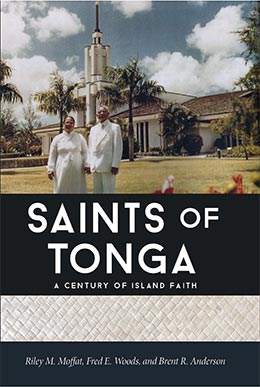Expanding Church Education and Preparing for Stakehood (1960-69)
Riley M. Moffat, Fred E. Woods, and Brent R. Anderson, "Expanding Church Education and Preparing for Stakehood (1960-69)," in Saints of Tonga (Religious Studies Center, Brigham Young University; Salt Lake City: Deseret Book, 2019), 255–312.
Labor Missionaries
The 1960s proved to be a decade of miracles with major outpourings of faith and unprecedented growth for the Church. It began with a visit from Elders Wendell B. Mendenhall and George Biesinger on January 11, 1960. They came to complete the arrangements for thirty-one Tongan labor missionaries who were going to Hawai‘i to help build additions to the Church College of Hawaii (CCH), the Hawaii Temple, and later the Polynesian Cultural Center (PCC). Elder Mendenhall asked the men how many of them were married:
Thirteen of them raised their hands. . . . I said, “How many of you married men are willing to leave your wife for two or two and half years?’ Every hand came up. The hand of the youngest of the married men came up and went down quickly, and he said, “President Mendenhall, I just got married today. Will you give me a chance to tell my wife?” Thirty days later I went back to make final arrangements with the government for these people to go. . . . I heard the branch president speak. He said, “Brother Mendenhall, we have taken care of every one of these brethren’s families, 13 of them. They will be properly housed; they will be properly clothed; they will be properly fed, and taken care of 100 percent for two and a half years while these men are gone. And more than that, when these boys’ missions are finished, we will have available the funds to send their wives to the Hawaiian Temple so that they can go to the House of the Lord.”[1]
This would provide an opportunity for many of these men to attend a temple. Although the Church did not pay the way for their families if they were married at this time, some families were eventually able to be sealed in the Hawaii Temple. After their missions, a few of the missionaries, such as Sione Feinga and Tui‘one Pulotu, stayed in Hawai‘i, attended the Church College of Hawaii, and became stalwart members of the La‘ie community.
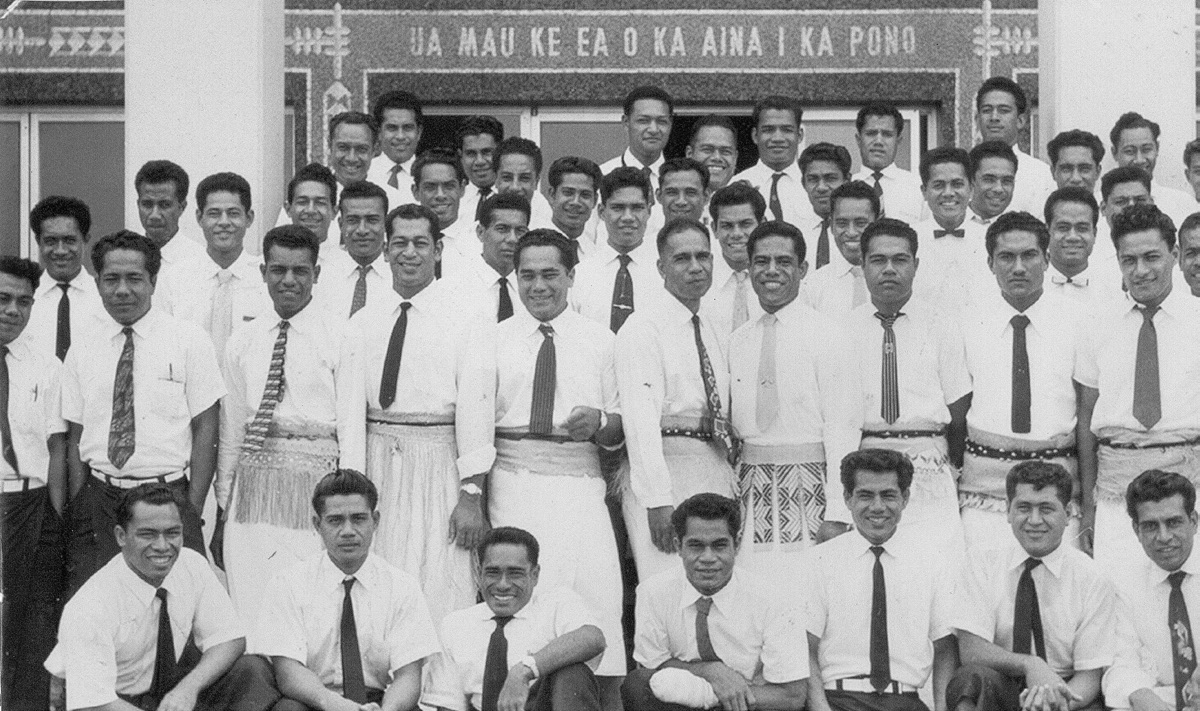 Labor missionaries who went to Hawai‘i. Alice Pack from Riley Moffat.
Labor missionaries who went to Hawai‘i. Alice Pack from Riley Moffat.
On January 5, 1961, Elder Mendenhall, chair of the Pacific Board of Education, arrived in Tonga. He met with the families of the building missionaries in Hawai‘i and announced the opportunity for them to join their husbands in Hawai‘i and be sealed in the Hawaii Temple.
The leadership of the mission at that point consisted of Mark Vernon Coombs, president, and the five district presidents: Elders Eric B. Shumway on Tongatapu, Douglas Banks in Ha‘apai, Duane Hiatt in Vava‘u, Floyd Wilcox on Niue, and Calvin Todd in Fiji.
The Church was growing rapidly on Niue. One-tenth of the island’s inhabitants were Latter-day Saints, who were organized into eight branches.[2] When a violent hurricane struck Niue on January 18, 1960, 4,000 of the 4,700 people on the island were left homeless. However, the Latter-day Saint concrete block chapel suffered only minor damage. This hurricane also damaged crops on Niuatoputapu, prompting President Coombs to go to Vaipoa and distribute twenty-one sacks of yams to the members.[3]
A very memorable day occurred on March 17, 1960, when the first copies of the Tongan-language Doctrine and Covenants and Pearl of Great Price arrived in Tonga. They had been translated by Elder Ermel Morton in his spare time as he served as the principal of Liahona College in 1954.[4] Now, all the standard works of the Church were available in Tongan. This was a tremendous help in developing local leadership.
Morton related an event that occurred in Vaotu‘u that indicates the changing attitudes toward the Church. The chief of that village complained to the noble of the area, Tu‘ivakanō, that he didn’t want any Latter-day Saints in his village. The noble replied, “There are many Mormons in my village of Nukunuku and they support me well and there are many Mormons in my village of Matahau and they also support me well. I wish that all of you were Mormons.” Thereafter, on June 17, a branch was organized in Vaotu‘u with Nafetalai ‘Alusa as president.[5]
Another milestone was reached on October 26 when Liahona High School held its first seminary graduation and thirty-seven students received their graduation certificates. By the end of 1960, the mission recorded 519 convert baptisms, over three times the number baptized the year before.
Elder John Longden, an Assistant to the Twelve, arrived December 1 on official Church business.[6] He had a visit with Prince Tungī, then left two days later after setting apart Kenneth Lindsay as first counselor in the mission and Manase Nau as second counselor, replacing Tu‘iketei Pule and Misitana Vea.
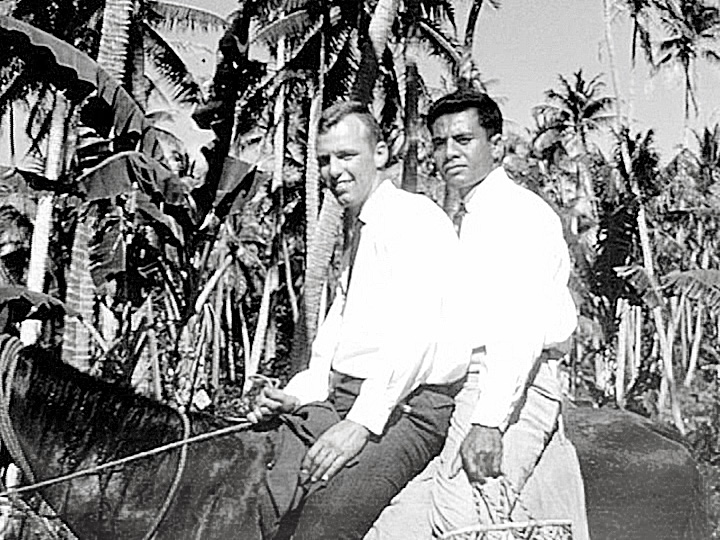 Elders Eric B. Shumway and Alama Tausinga. Courtesy of Eric Shumway.
Elders Eric B. Shumway and Alama Tausinga. Courtesy of Eric Shumway.
Elder Eric Shumway, who served as a missionary from 1959 to 1962 and returned in later years as mission president and temple president, explained the value of po malanga (preaching at night) or po hiva (night singing), which the missionaries started implementing on Tongatapu in 1960 as a proselytizing tool. For example, missionaries would sit around a lantern in the middle of a village singing hymns and then preach the gospel in booming voices that could be heard throughout the village. The people who might be interested in the Church but for whatever reason did not receive the missionaries in their homes during the day could hear them at night.[7]
As a missionary, Elder Shumway also shared the efficacy of using the traditional kava circle as a method of introducing the gospel to the hou‘eiki (chiefly class). Elder Shumway, who had become fluent in the chiefly language of respect, had the matapule (talking chief) title of Faivaola bestowed on him by the noble Nuku in May 1961. By having this chiefly title, he had status and respect in faikava circles with the chiefly class and could speak with them and share the gospel in settings other missionaries could not.[8] Unfortunately, the practice of faikava is now so abused that it is no longer an appropriate venue for proselytizing activities, but at that time President Coombs saw faikava as a valuable setting for preaching. Encouraged by President Coombs, Elder Shumway developed a new missionary discussion booklet that focused on presentation and preaching rather than on questions and answers, which often seemed too aggressive or disrespectful in Tongan culture.
Hurricane Strikes Vava‘u
In February 1961, President and Sister Coombs accompanied a group of Tongans going to the temple in New Zealand. After returning, the Coombs family sailed to the northern islands in March to hold district conferences. While they were at Ha‘apai, a massive hurricane struck and left great destruction in its wake. The storm tore off the roofs of the Ha‘alaufuli, ‘Otea, Tu‘anuku, and Leimatu‘a chapels in Vava‘u, where the most extensive damage was suffered.[9]
During the storm a number of acts of heroism and miracles transpired. These stories were recorded two weeks later in interviews by Elder Vernon Lynn Tyler with President Coombs and his wife LaVera, who were in Ha‘apai, and Elder Eric Shumway, who was in Vava‘u.[10] President Coombs was no stranger to South Pacific hurricanes, having survived a life-threatening hurricane in February 1926 aboard a small sailboat in these same waters. This time in Ha‘apai, they witnessed many of the Tongan homes being blown apart in the wind. Not long before, Manase Nau, a counselor in the mission presidency, had warned the Saints during a district conference that if they didn’t pay their tithing, the Lord was not bound to help them in times of trials to come. This promise was also reported to have been given by Elder George Albert Smith during his visit in 1938.[11]
In Neiafu many of the doctors and nurses at the hospital were not available to help their patients except young Latter-day Saint dental assistant Vili Pele Folau. In Tu‘anuku, Mosese Langi led his neighbors to safety, completely disregarding his own safety. Throughout Vava‘u, the people fled to the new concrete block Latter-day Saint chapels for refuge, even those who had said disparaging things about the Church. President Coombs said that Elder Shumway “was here and there and everywhere bringing anybody [to the chapels]. He had no regard for his own life. . . . He paid no attention in regards to what church or denomination they belonged to, he was there helping them all.”[12]
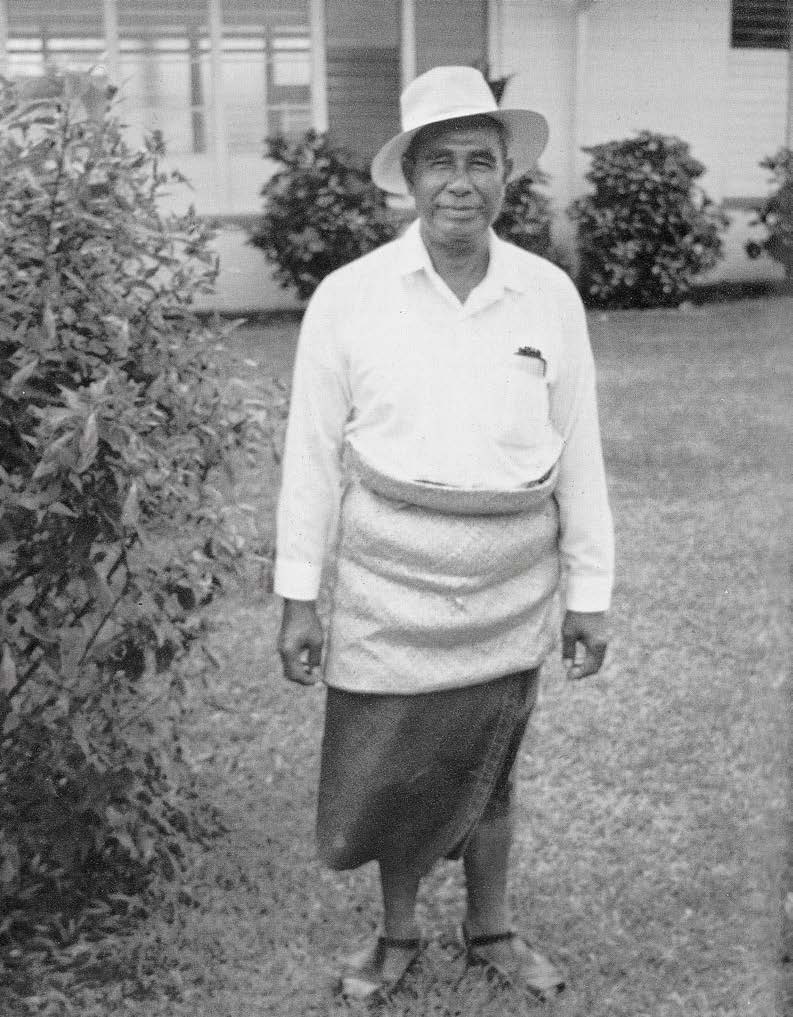 Tonga Poteki Malohifo‘ou. Paul Cheesman, Early America and the Polynesians.
Tonga Poteki Malohifo‘ou. Paul Cheesman, Early America and the Polynesians.
The hurricane hit Vava‘u on March 15, 1961, and Elder Shumway shared his experiences in an interview on April 1. According to Elder Shumway, he was celebrating with all the other missionaries since he had been transferred to Tongatapu (his replacement was Elder David Murdock) and was supposed to leave on the boat the next morning, but the wind picked up and fallen trees blocked the road. He and the other Tongan missionaries began telling everyone to go to the Neiafu chapel. The next morning the winds were blowing 150 miles per hour and were knocking down the large Wesleyan and Free Church chapels, and the Catholic Church building was already severely damaged. Eventually Elder Shumway estimated that 80 percent of the houses in Neiafu had been destroyed or badly damaged. Even the wooden chapels at Tu‘anekivale, Tefisi, and Koloa were carried away in the wind.
Elder Shumway told the story of Tonga Poteki Malohifo‘ou, a faithful and dedicated branch president in Neiafu, a man of great power in the priesthood. When he didn’t show up at the chapel during the height of the storm, Elder Shumway and Vili Pele Folau went looking for him. President Malohifo‘ou’s fragile wooden framed house elevated on three-foot posts was in perfect condition while all his neighbors’ houses were totally blown away. He told Elder Shumway he had been afraid to take his ailing wife and several little children out into the storm, certain they would be killed. So he stood on a chair, grasped the roof rafters, and through the power of the priesthood, blessed the frail structure to stand securely, even the little fale peito (eating shack) outside. After a couple of hours when the winds had subsided, President Malohifo‘ou brought his family to the chapel and took charge of the 150 refugees huddled inside.[13] Later it was discovered that only seven nails held his roof on.
As he surveyed the destruction, Elder Shumway noticed that in general the houses of families who had welcomed the missionaries and allowed them to hold po malanga (cottage meetings) remained standing.
After the hurricane, President Coombs immediately sent Fakatou Vaitai and ten other men from Tongatapu to begin repairs of Church buildings in Vava‘u, and leaders in Salt Lake called Archie Cottle to go there to supervise. Brother Cottle also brought a large supply of welfare food supplies along with baskets of sweet potato plantings. The government officials seemed not to be helping Latter-day Saints as much as other people in recovery efforts because they believed the Church had the resources to take care of its own members.[14]
At a district conference held in Vava‘u on September 17, the district was divided into the North Vava‘u district with seven branches, led by Malakai ‘Unga, and the South Vava‘u district with eight branches, led by Tonga Malohifo‘ou. On Tongatapu, the Nuku‘alofa Branch was divided on November 5 with the First Branch being led by Hale Vete and the Second Branch led by Loiti Talakai. Within a week a temple excursion to New Zealand sailed from Nuku‘alofa on November 11 on the Aoniu. President Coombs noted that by the end of the year Vava‘u had rebounded from the March hurricane, was already exporting bananas, and was abounding in watermelons. Yams, manioke, and kumala were also plentiful, but it would take years before the coconut trees would again produce copra.
An important issue that came up during this time was the Church’s lease of the property on which Liahona was built. The lease was coming due in 1961, and the noble, Lavaka, who controlled the land through birthright and inheritance, was not being very cooperative in renewing the land lease. He was desirous that the Church return to him 76 of the 276 acres that he had leased to the Church at Liahona, and he wanted to raise the lease rent on the rest of the property. Principal Kenneth Lindsay asked President Coombs what he should do, but Coombs referred him to the Pacific Board of Education. The board sent Elder Wendell Mendenhall and President Edward Clissold of the Oahu Hawaii Stake to Tonga on October 26, 1961, to sort out this matter with the help of Prince Tungī. Elder Mendenhall reported that “Prince Tungī gave the finest cooperation.”[15] Liahona was able to renew the lease for 200 acres for a term of forty-five years for $1,150 per year.[16]
Under President Coombs, the baptisms in the mission had risen from 147 in 1959 to 500 in 1961, and all the district presidents in Tonga were now native Tongans, although the district presidents in Fiji and Niue were still expatriate missionaries. President Coombs received authorization on January 22, 1962, to build four small chapels on Niue to replace ones that had been condemned by the government the previous August. They were expected to cost £100 each.
While President and Sister Coombs were holding district conference in Suva on March 1, they were notified that Elder Mark E. Petersen and his wife, Emma, had arrived there. The Petersens and Coombses flew to Tonga, where Elder Petersen of the Quorum of the Twelve met with 2,215 Saints at Liahona. Then they chartered the Kao for £100 and sailed to Ha‘apai to meet with the Saints. The Petersens flew out on March 10. From this visit, Elder Petersen recommended that Fiji be made a separate mission. President Coombs received a letter from the Quorum of the Twelve on May 20 approving the recommendation, but no action was taken at that time.[17]
Many members of the mission council—including Siosifa Tu‘iketei Pule, Maile Mataele, Sione ‘Iongi, Siosiua Tongahema, Paula Malupo, and Sione Taufa Tongi—were getting on in years and were having difficulty getting around to all the branches. Therefore, on June 30, younger men were called, including several Liahona faculty members. The members of the Hihifo District demonstrated their dedication when 910 out of 1,086 members of record showed up for their district conference on September 30, 1962.
After a very successful mission, President Coombs received notice from the First Presidency of his release. Patrick Dalton, who had been one of the early missionary teachers at Liahona and who had been working for the United Nations in South Korea, was called to be his successor.[18] President Dalton was called directly from Korea and set apart by Elder Gordon B. Hinckley in Tokyo. He was not able to go to Salt Lake City for mission president training, and only much later did a General Authority come to Tonga to work with him. Dalton stated that he just relied heavily on the Holy Spirit to give him guidance in running the mission.[19]
Patrick D. Dalton Replaces Mark Vernon Coombs
President and Sister Patrick Dalton arrived in Tonga on February 7, 1964, and were instructed by President Coombs on the operation of the mission. The next day they were taken around and introduced to the people in Nuku‘alofa with whom they would be working. On February 9, President and Sister Coombs flew home to Salt Lake City, having served twelve years during three missions in Tonga over a period of fifty-three years from 1911 to 1964.
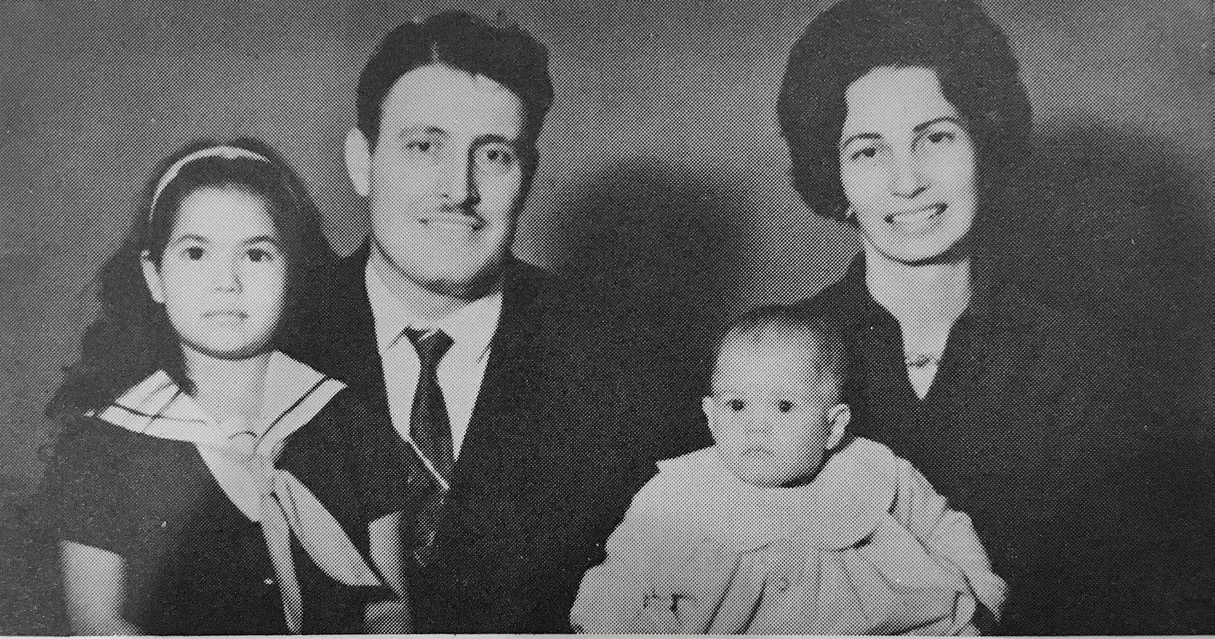 President Patrick and Sister Lela Dalton. Alice Pack collection.
President Patrick and Sister Lela Dalton. Alice Pack collection.
President Dalton met with the district presidents on Tongatapu and began training them on the new Handbook of Instructions for District and Branch Presidents in Missions, which had recently been issued by the Church. He also instituted monthly audits and distributed the branch and district records that had been kept in the mission office out to the districts and branches. He organized a mission council and separate district councils modeled after stake councils to prepare the districts to someday become stakes.
President Dalton and Manase Nau sailed to Suva on March 5 to meet with Brother Wendell Mendenhall to discuss the building program. The next day, they, along with Fiji District president, Elder Howard Wolfgramm, met with Maurice Scott, the Church’s attorney in Fiji and the president of the Fiji legislature. They talked about getting official recognition for the Church in Fiji, as well as the possibility of building a Church school and finding a potential site for it. At the district conference, President Dalton told the Saints in Fiji to prepare to accept positions in the branches and the district as the Church grew. As President Dalton and his counselor Manase Nau returned to Tonga on the Matua, the ship encountered a severe hurricane with 100-mph winds and 50-foot waves breaking over the ship. Radio communication and radar were lost, and half of the ship’s bridge was blown away. Amid the hurricane, President Dalton and President Nau were holed up in their cabin, but many of the other passengers stayed in the dining salon and sang songs as though they were unconcerned. The captain later asked President Dalton why the natives seemed so calm. A spokesman for the passengers told him, “Oh, we weren’t worried about this ship sinking. The Mormon mission president was on board.”[20] Instead of continuing on to Nuku‘alofa, where he thought the hurricane was headed, the captain changed course to Apia, Samoa, to make some repairs. Because of this, the usual one-and-a-half-day voyage to Nuku‘alofa took eight days.[21]
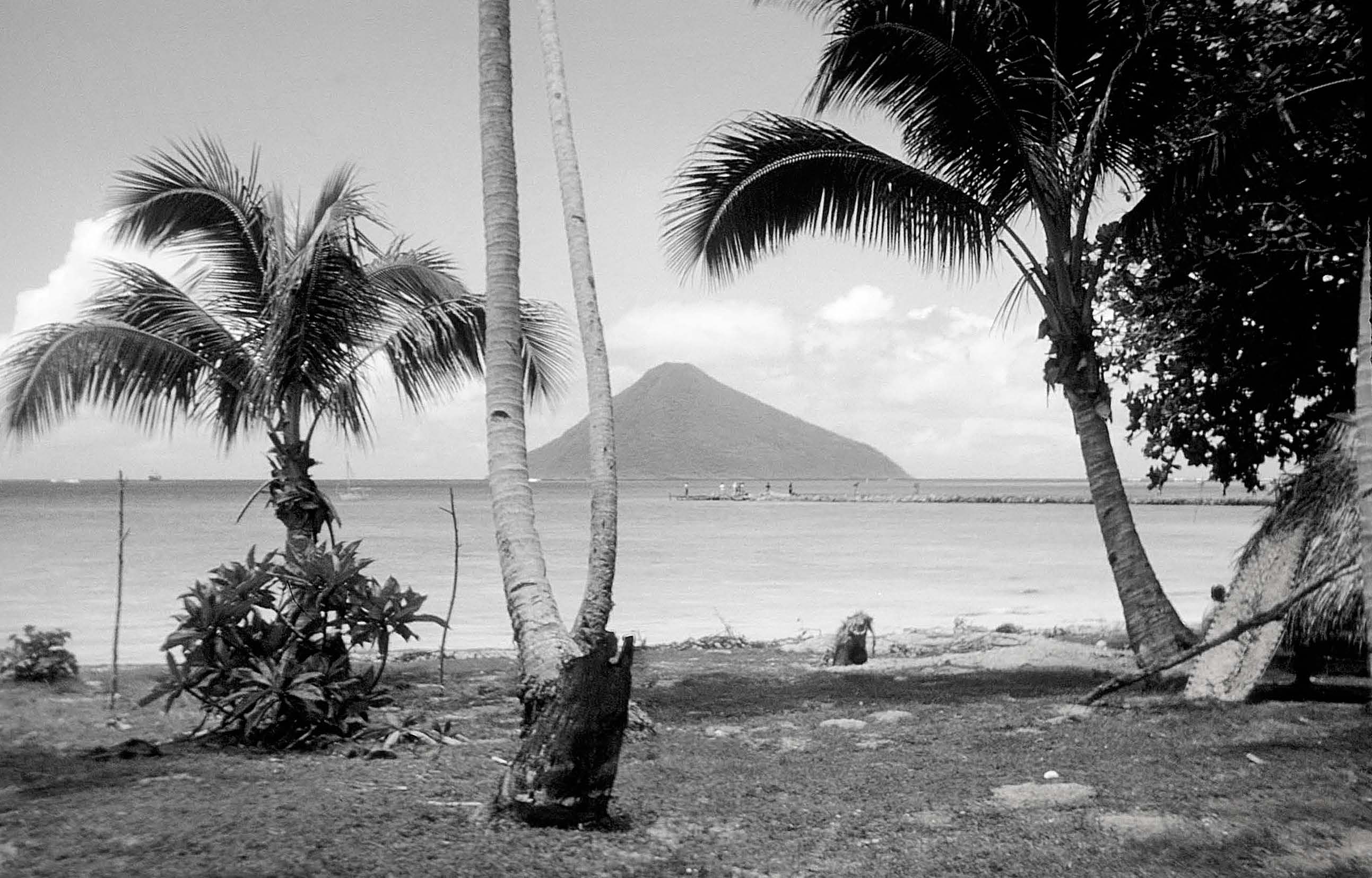 The island of Tafahi from Niuatoputapu. Courtesy of Don Milligan.
The island of Tafahi from Niuatoputapu. Courtesy of Don Milligan.
Back in Nuku‘alofa, President Dalton had the mission secretary compile a list of all male members over twenty-one holding only the Aaronic Priesthood and all unordained male members over twelve so that activation efforts could begin with these brethren. Many responded to this invitation.
An indication that the Church had spread all over Tonga was that on Apri1 6 Elder Lynn Cottle and a group of Saints from Niuatoputapu journeyed five miles to the high volcanic island of Tafahi. There they met with the members in the lone village on the island under the leadership of Elder Semisi ‘Alatini, a missionary branch president serving with his family. There was no landing, so the boats had to lay offshore. To reach shore, boat passengers either had to arrange for a poupau, or dugout outrigger canoe, to pick them up or to swim to shore.[22]
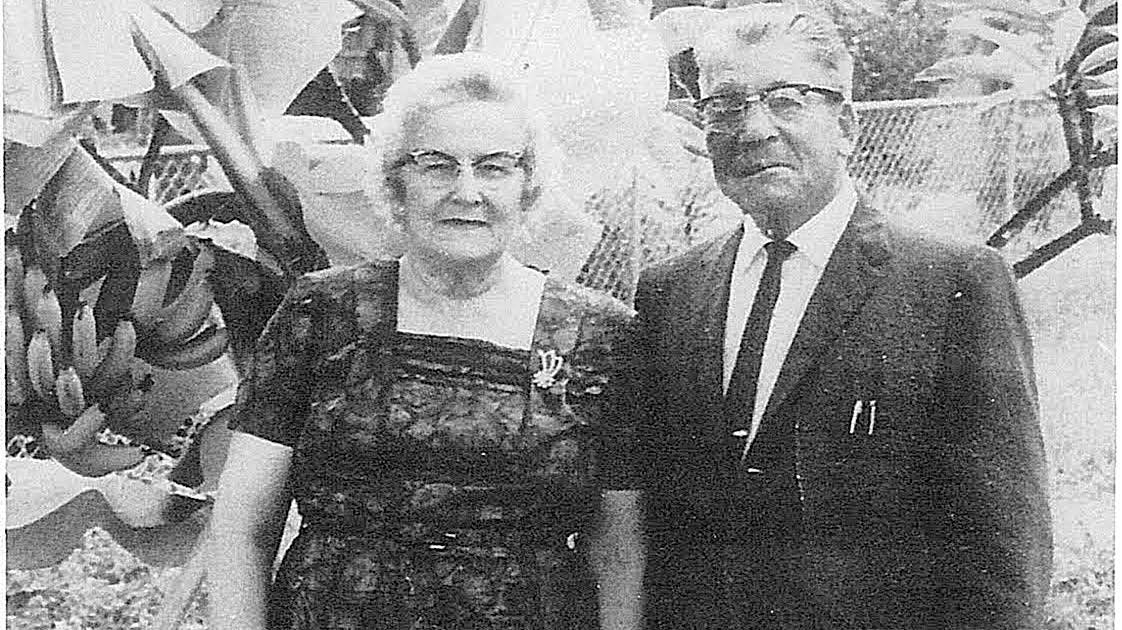 Janette and James Wyatt. Courtesy of Gospel Doctrine Plus.
Janette and James Wyatt. Courtesy of Gospel Doctrine Plus.
By this time, a few Tongan families had emigrated overseas, and the Church was now calling some of their children back to Tonga to serve as proselytizing missionaries. Early in 1963, Mele and Rodney Fakatou, children of Samuela and Heleine Fakatou, received their calls to return and serve in Tonga, and later Paul Wolfgramm was called to Tonga. Elders Norman Harris, Barry Wishart, and John Mannering were called from New Zealand, and Elder Emil Wolfgramm from Hawai‘i.
Tragic news arrived on August 1 that Sister Janette Wyatt, wife of Elder James Wyatt, had passed away on Niue. After being notified, President Dalton, working with the U.S. consul in Suva, tried to arrange a seaplane to bring the body to Suva for embalming and repatriation to America, but the arrangements were too late and she was buried on Niue. The law required that the body be buried within twenty-four hours of death.[23] President Dalton recalled, “Her death on that island did more for the people there in helping them to better understand the gospel. She was buried in her temple clothes. Her death opened up many homes to the missionaries.”[24] The people just didn’t want to let her go. It took eight years to finally get her remains shipped back to Utah. In the meantime, the presence of her grave in Niue boosted the missionary efforts there.
Changes in Church Schools
A new tradition was initiated at the graduation exercises of Liahona High School on November 9, 1963, when all young men in the graduating class who were old enough were called to attend a missionary school. They then went out on splits with the regular missionaries. There they would receive training and be given the opportunity to accept a call as a full-time proselytizing missionary. Two-thirds of the class responded to this call that first year. One of that first group was Sione Fineanganofo, a convert who was baptized at Liahona in 1961 and who later became an Area Seventy. The following year almost all the seniors of an appropriate age accepted a call to serve. By then, there were about two hundred native missionaries and the six palangi missionaries allowed by the government.
Another missionary school was conducted for all the 1964 graduates of Liahona High School. Morton noted, “Most of the young ladies have accepted the call. This is the first time local young ladies have been called with the plan for them to serve entirely as proselyting missionaries.”[25]
On October 25 Liahona principal Kenneth Lindsay was replaced by Rondo Harmon. President Dalton, with help from Principal Harmon, began making dramatic changes to the Church schools in Tonga. One important and lasting development occurred when Liahona inadvertently accepted more students than they could accommodate in the dorms. Seven hundred twenty students had been accepted, but the boys’ and girls’ dorms could accommodate only 280 each.[26] President Dalton recalled that Brother Harmon came to him and said,
“What in the world am I going to do?” So we sat down and talked about it and prayed and thought and talked some more. Pretty soon we realized we have all these chapels that are being used Sunday, Tuesday afternoon for Primary, Tuesday evening for Mutual, and Tuesday morning for Relief Society. On Monday, Wednesday, Thursday, and Friday, the buildings are sitting there empty. We were sure that with the Mutual and the Primary there would be no problem, and we could surely work out the problem with the Relief Society. Why couldn’t we take all these youngsters that live on Tongatapu, send them home, and then send teachers out to the chapels and start holding schools in the chapels.[27]
This is how the middle school program started. A benefit was that the younger children—of ages comparable to children in seventh, eighth, and ninth grades—could stay at home with their families rather than in the dorms at Liahona. This was later expanded to include the other islands. An offshoot was the development of a teacher training program at Liahona for graduates to develop teachers for these middle schools. President Dalton also appointed the missionary sisters assigned to serve in the mission office to teach seminary classes at the new Liahona Junior High held in the Fasi chapel.
On February 27, 1964, Principal Rondo Harmon also proposed more vocational programs such as agriculture to better prepare students for more Tongan employment opportunities. He also suggested the possibility of sending some of the more academically inclined students to the Church College of New Zealand to study there and take the New Zealand school certificate and university entrance exams to help them prepare for higher education.[28] The Church College of New Zealand proposal was not followed up on.
The number of convert baptisms in 1963 totaled 554, and the mission council resolved to set a goal of one thousand baptisms for 1964. Over the summer, Harmon requested that the activities of the student branches at Liahona be more closely integrated into the Liahona school program.
On January 5, 1964, a message arrived from New Zealand that ‘Ilaisa Tupou Ma‘u had passed away during the temple excursion after completing his own work and forty other endowments. He was a chief and the only member of his family to join the Church. When he was baptized, the royal families insisted that he surrender his seat among the nobles of Tonga, and his family also left him. President Dalton recalled that all the nobles attended the funeral, which was preached by Viliami Sovea Kioa, a stalwart member and matapule (counselor) to the king. He gave a magnificent sermon on the plan of salvation. Before long Brother Ma‘u’s sons joined the Church along with many others in his village of Malapo.[29]
Over the summer, Vava‘u experienced a serious drought since rain had not fallen in two and a half months. The Saints in Koloa met with President Dalton to ask for help. At a feast that afternoon, President Dalton asked Tonga Toutai Paletu‘a to ask a blessing on the food. Brother Paletu‘a also prayed for rain. As the meal proceeded, a cloud appeared over Koloa, and it began to sprinkle. As the group walked back to Ha‘alaufuli, the sprinkle became a downpour that lasted all evening and all night and filled all the area’s cisterns. Brother Paletu‘a, a small and humble man, became one of the greatest leaders of the Church in Tonga. The following week the same thing happened in Ha‘apai, which had also been experiencing a drought.[30]
President Dalton organized the ‘Eua District on April 7 because it was easier to have mission leaders go to ‘Eua for conferences than to bring the ‘Eua Saints to Tongatapu. He also visited Niuafo‘ou to meet with the seasonal copra harvesters living temporarily on the island. At that time there were fourteen Latter-day Saints in four families.[31]
As early as August 18, 1961, the Pacific Board of Education was charged by Church authorities to replace expatriate teachers with Tongan teachers as they returned from their training overseas. Bill Harris and Tupou Pulu were the first to return after they graduated from the Church College of Hawaii.
In 1964, reacting to criticisms that Liahona was modeled after an American high school and did not prepare students for life in Tonga, the Pacific Board of Education and Liahona administrators began considering adopting the government’s curriculum and examinations that would qualify the students to receive Tongan “higher leaving certificates.” The board also approved the middle school program.[32]
On November 23, amid a hurricane with 90-mph winds, a call came that a plane was landing with Elder Delbert Stapley of the Quorum of the Twelve; Dr. Harvey Taylor, chancellor of Church Schools; and Dr. Owen Cook, president of the Church College of Hawaii, arriving to inspect Liahona High School. The Brethren had dissolved the Pacific Board of Education, and all Church schools worldwide were administered by the chancellor in Salt Lake.[33] The bad weather abated almost immediately after their arrival. The group visited several branch chapels that had been suggested to host Liahona junior high schools. This plan was met with favor by the visiting authorities. On November 27 the group proceeded on to New Zealand to inspect the Church College of New Zealand.[34]
During a visit to Fiji on May 27, 1964, the Church’s legal counsel in Fiji, Maurice Scott, introduced President Dalton to Sir Derek Jakeway, governor of Fiji, regarding official recognition of the Church in Fiji. Dalton took the opportunity to extend an invitation to visit Liahona when the governor visited the following week. Governor Jakeway was deeply impressed.[35]
In July 1964 the Church began broadcasting programs over the government radio station ZCO. The programs had to be prerecorded and approved by a Radio Board of Review. However, there were no Latter-day Saint representatives on the Board, and the Wesleyan Church objected to the doctrine being presented by The Church of Jesus Christ of Latter-day Saints. The mission felt this was a restriction of free speech.[36] Yet these radio programs continue to this day and have done a great deal of good.
A new proselytizing program focused on interesting youth of the villages in sports such as volleyball; the missionaries then looked for opportunities to discuss the gospel with the groups of young people. The missionaries also used service opportunities to make contact with members of other faiths. These kinds of service and fellowshipping activities were more effective than tracting since each home in every village had been approached many times already.
President Dalton was informed on May 18 by Mr. Robert Finau, deputy commissioner of Inland Revenue, that all the missionaries must file income tax returns. Mr. Finau said, “The Mormon missionaries must be paid the same as the teachers [at Liahona]. Both teachers and missionaries are paid in the Wesleyan Church.”[37] He, as a director of the Wesleyan Church, apparently could not comprehend that the missionaries served without some kind of pay. This eventually was sorted out with the help of the director of Inland Revenue. As a result, the Wesleyan Church announced on June 4 that their missionaries would now serve without pay in an effort to combat the successes of the Latter-day Saint missionaries. The Church of Jesus Christ of Latter-day Saints had already baptized 670 people so far in 1965, compared to 230 the previous year at the same time.[38]
In July, Elder Alex Wishart, a part-Tongan from New Zealand who had acted as Elder George Albert Smith’s companion during his 1938 visit to Tonga, arrived to commence his assignment as the district president on Niue. A missionary school, or small MTC, was also completed with eighty-four graduates, including several couples, such as Ha‘unga and Sela Feinga, who would be serving as branch leaders on remote Fotuha‘a.[39] Another graduate of that missionary school was Sister Malia He‘inu‘usila, who gave birth on board the Tofua on her way to serve with her husband as branch leaders in a remote branch in Vava‘u.[40]
The year 1964 ended with 838 baptisms, just short of the goal of one thousand. It was an increase of ten percent in the membership of the Church in Tonga. As 1965 commenced, President Dalton and the mission council set a goal of one thousand five hundred baptisms for the year. President Dalton continued to reorganize the mission leadership to more closely reflect what a stake would look like in preparation for that eventuality.
A large new mission boat was built under the supervision of Fakatou Vaitai and Efalame Wolfgramm. It was named the Faifekau (missionary).[41] The newly built boat was launched at Ha‘apai on April 21 and arrived at Nuku‘alofa, via Nomuka, on April 29. Princess ‘Ofeina was the guest of honor on May 12 for the hopoki ceremony (the first person to go on board and declare the boat fit for service). It was later sold to a Latter-day Saint entrepreneur, ‘Uliti Uata, when it was deemed redundant and expensive to operate.
Several Tongan graduates from the Church College of Hawaii returned on January 25 to start work as teachers at Liahona. They were Sione Lātū and his wife, Helen, Viliami Hemaloto, Moli Ngatuvai, and Nanasi Fine. They had been preceded by Bill Harris, who had been the valedictorian at the Church College of Hawaii, and Tupou Pulu, who was put in charge of the middle schools in 1965. President Dalton also met with leaders at Liahona High School to refine the operation of the student branches since there was no Melchizedek Priesthood, Relief Society, or Primary in those branches. All positions in the student branches, except for the branch president, were held by students.[42] By July 10, 1966, there were four student branches at Liahona, two conducted in English and two in Tongan, with one-fourth of the boarding students in each branch.[43]
On May 4, 1965, three hundred boys from the Liahona dorms walked off campus protesting unfair treatment by non-Polynesian faculty and staff and unfair dorm rules. The structured life expected of the boys could be a challenge for some of the young men who were used to a less disciplined routine. Many of the younger boys were apparently coerced into joining the protest. It was led by a student from Tahiti and was meant to coincide with a visit from Dr. Harvey Taylor, chancellor of Church Schools. The boys who were involved were expelled and could only be reinstated if they came with their parents and requested readmission. The boys were eventually readmitted with the exception of the young man from Tahiti, who was permanently expelled and sent home.
The 1965 Liahona graduation was held in the newly constructed gymnasium on October 30. It had cost $350,000 and was the finest facility of its kind in the kingdom. The facility has been heavily used for both school and Church functions ever since.
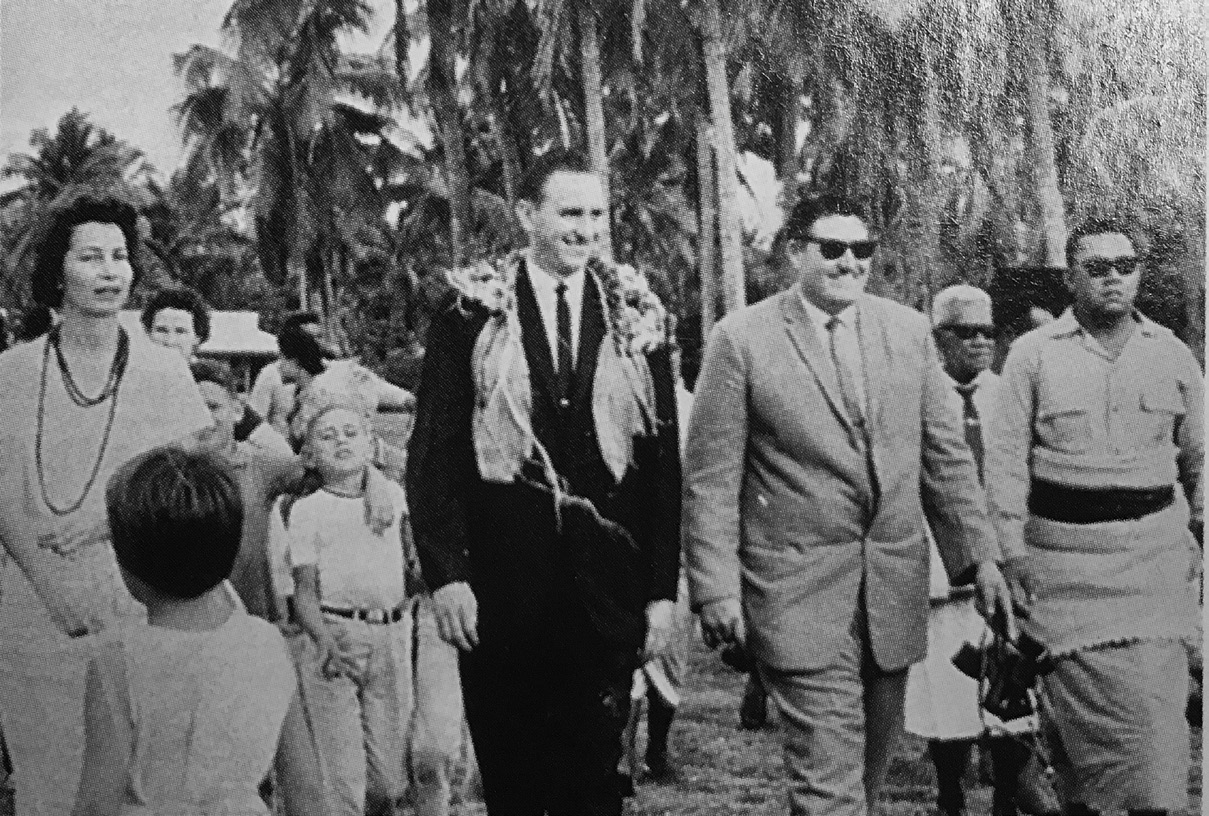 President Patrick and Sister Lela Dalton with Elder Thomas S. Monson. Ensign August 2014.
President Patrick and Sister Lela Dalton with Elder Thomas S. Monson. Ensign August 2014.
In a subsequent master’s thesis Delworth Young, a vice principal at Liahona, identified the key issues facing Liahona in 1965, questioning whether Liahona was an academic institution or a missionary tool, finding the right kind of expatriate teachers who could adjust to Tonga, and resolving issues of the Tongan/
Elder Thomas S. Monson, who had been assigned along with Elder Paul H. Dunn to supervise the South Pacific Area, arrived on November 2. Elder Hugh B. Brown was supposed to accompany them but was called back to Salt Lake City at the last minute. At Liahona the Saints performed a tali tu‘uta ceremony, usually reserved for greeting nobility. Speaking to the Saints at Liahona, Elder Monson challenged them to prepare for stakehood. Elder Monson dedicated new chapels at Tokomololo, Houma, and Fo‘ui and then met with 179 missionaries.
On December 15 the Tongan government announced over the radio that their beloved Queen Salote had passed away in Auckland, New Zealand. A meeting was held for all mission leaders and Liahona administration two weeks later to discuss policies dealing with the mourning of Queen Salote. It was announced that “all mission, district, and branch organizations should adhere to Tongan traditions and customs during this period of respect.”[45] This guideline included all non-Tongan Church members in the kingdom. The year ended with 1,108 convert baptisms, nearly 400 shy of the goal of 1,500. But it still amounted to about 12 percent of the entire population of the kingdom.
The mid-1960s brought forth many blessings for the Tongan Mission, along with a renewed sense of energy, fulfilling prophecy from decades before by some of the faithful and humble leaders of the Church. The Church had begun to grow rapidly with the building and dedication of Liahona as well as new meetinghouses that dotted the villages.
John H. Groberg Replaces Patrick D. Dalton
As President Dalton was nearing the end of his three-year tenure as mission president, a call was extended to John H. Groberg to replace President Dalton as mission president. At the time, John Groberg was serving as a bishop in Idaho Falls, Idaho.
President Groberg arrived in Tonga on July 5, 1966, with his wife, Jean, and their five young daughters. He had served a distinguished mission in Tonga from 1954 to 1957 and was known throughout Tonga as “Kolipoki,” the closest the Tongans could come to pronouncing “Groberg.” Dalton visited with the incoming mission president for several days and took him to visit business and government officials. President Groberg absorbed all the information he could from his predecessor prior to the Daltons’ return home. The evening before the Daltons’ departure, more than two thousand people attended a large feast and party in the newly constructed gym at Liahona as a farewell for President Dalton and a welcome for President Groberg. President Dalton and his family left Tonga on July 7, 1966, bound for Hawai‘i, where Dalton became the botany professor at the Church College of Hawaii.
Significantly, between Groberg’s arrival as a missionary in 1954 and his assignment as mission president in 1966, Tongan mission statistics showed a growth from 3,280 members in 1952 to a membership of 11,366 in 1967, an increase of 347 percent. There were now fifty-seven branches and eleven districts, with twenty foreign and fifty-four local missionaries.[46] When President Groberg was a young missionary, the mission averaged seventy-five baptisms per year. When he returned, the mission was enjoying seventy-five baptisms per month. R. Lanier Britsch noted,
During this era the Tongan Saints matured and advanced in matters relating to leadership, Church organization, and spiritual enlargement; the constructing of chapels and other buildings for Church purposes; the improvement for teaching the gospel to nonmembers; and the growth and improvement of the Church school system in Tonga. The rapid growth of the 1950s and 1960s was to a degree an outgrowth of the work that had been done by earlier missionaries and members, but leaders in Tonga and Utah made many changes in the way Church matters were handled, and these changes brought significant results.[47]
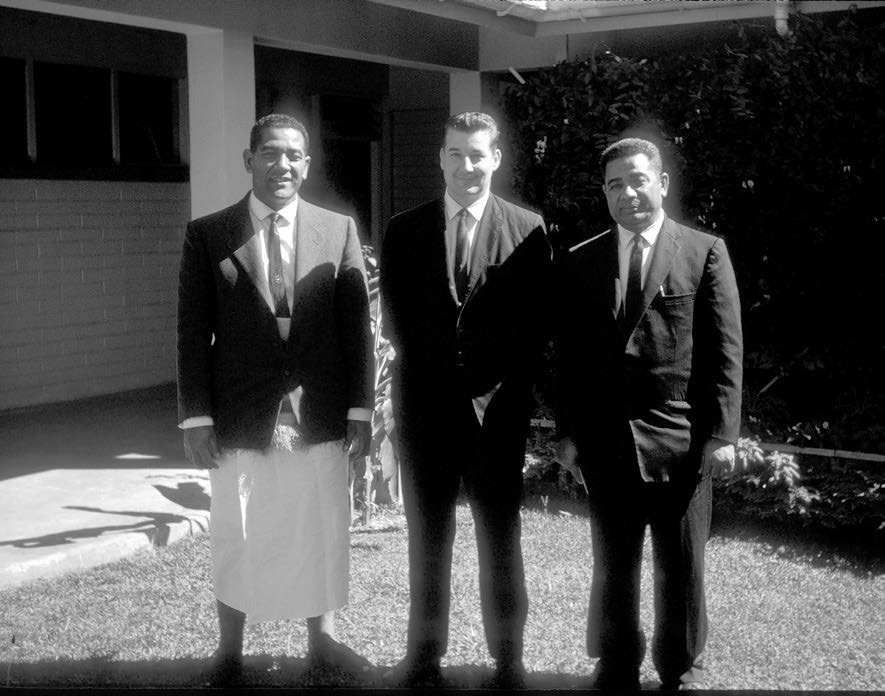 President John Groberg and his
President John Groberg and his
counselors Manase Nau and Tonga Toutai Paletu’a. Courtesy of
John Groberg.
When the soon-to-be crowned king of Tonga, His Majesty Taufa‘ahau Tupou IV heard that John Groberg was returning to Tonga, he was very happy because of the close relationship and friendship they had developed years before. It would prove to be the beginning of many visits by President Groberg to the royal palace to meet with the king. President Groberg noted that after Queen Salote passed away, there seemed to be more opening up, more westernizing, and less connection between church and state in Tonga. King Tupou IV had been educated overseas and had some new ideas.[48]
The very next day, President and Sister Groberg, Brother and Sister Rondo S. Harmon (principal of Liahona High School), and Brother Ralph Olson of the Church College of Hawaii had a formal visit with King Taufa‘ahau Tupou IV at the royal palace. Among topics discussed were the king’s interest in the Church College of Hawaii, Liahona High School, and various Church topics. After the meeting, the king expressed his happiness at the return of President Groberg to Tonga. Groberg explained his close relationship with the king as follows:
When I was a young missionary the way I first became acquainted with Tungi and Mata‘aho was when they would come to Ha‘apai for vacation time and they had their two oldest children. . . . They would usually bring them with them, and I would often babysit those two kids, they were about 9 or 10 . . . , and when I say babysit, I would just visit with them and read them stories and so forth, but we often did things with Tungi [the crown prince] and Mata‘aho. When I say “we,” I did. I didn’t have a companion on Ha‘apai, I was the district president. . . . When Queen Salote [Tungi’s mother] came to Ha‘apai in 1956, I would say, maybe 1957, of course Tungi and Mata‘aho had told her about me. [When she landed,] the school children would line up, and she would land, come on the wharf where the flag was raised, but they had never allowed the LDS Primary School which I had started in Pangai, to be part of it, but I talked to them [the royal family] and said, “Why not?” The Governor of Ha‘apai at the time, Noble Fielakepa, was a very close friend. Anyway, I got word, “Why can’t we be part of it?” And he said, “Well, I just don’t know.” And I said, “I’ll even play my trumpet for the raising of the flag!” And anyway, [the next time] came, she sent word ahead that she’d like to have the Mormon school and especially Kolipoki to play the posting colors and so I did!” I brought the kids and they lined up and we were front and center right next to Queen Salote, and I played the British to the colors, in a different tune than the American one, but I had learned it. She was a wonderful woman. She expressed deep appreciation for what we were doing, and particularly for this school that we were running.[49]
The first several months of President Groberg’s presidency were very busy with administrative work along with ministering to the Saints. On August 9, 1966, a priesthood leadership meeting was held at Liahona High School where two existing districts were combined. This new district was named the Hihifo District. Also at this meeting the Liahona Missionary Committee was organized, with Bert Nixon being called as the chair. The objective of the committee was to improve the image of the Church in the eyes of the leaders of the nation and to better educate the people of Tonga and to use the full facilities of the Church and the Liahona High School to help accomplish this goal.[50]
Shortly after his arrival in Tonga, President Groberg selected Manase Nau as first counselor (a carryover from the Dalton presidency) and Tonga Toutai Paletu‘a as second counselor. President Nau was a hardworking man in his role as counselor, traveling to many smaller islands and helping to conduct district conferences. He was a favorite among the proselytizing missionaries because of his dynamic personality. He also had close connections with the royal family and could accomplish things no one else could within the Church.
As President Groberg was seeking inspiration for his choice as second counselor, he said:
I met with the district presidents. And President Paletu‘a was the district president of the Hihifo district at the time. I met all of them and kind of got acquainted, and as I prayed about it, I just had a very strong confirmation to call President Paletu‘a to be [my] counselor. So, I did without knowing him at all other than just having met him along with many others. It just turned out to be that was the Lord’s very direct finger, because President Paletu‘a became the first Tongan stake president, became the first Tongan mission president, became the first Tonga Temple president. He was a great man. I think his life to me could be summarized in just one experience. One time I had an assignment and it was a difficult assignment, doesn’t matter what it was, but it had to be done. But it was hard, and I went over it with him, not really apologizing, but asked if he would be willing to do it. And I remember piercing eyes just looking, and he said, “President Groberg, anything that you want me to do I’m willing to do, not because I think I have any strength, but because I have faith in Jesus Christ. And I know that you’re working under his instruction and I know He will help me do whatever you ask. He will give me the help to do it.” I recall him as a very disciplined type of man, but his humility overshadowed everything. And the reason he was that way was because that was what it took.[51]
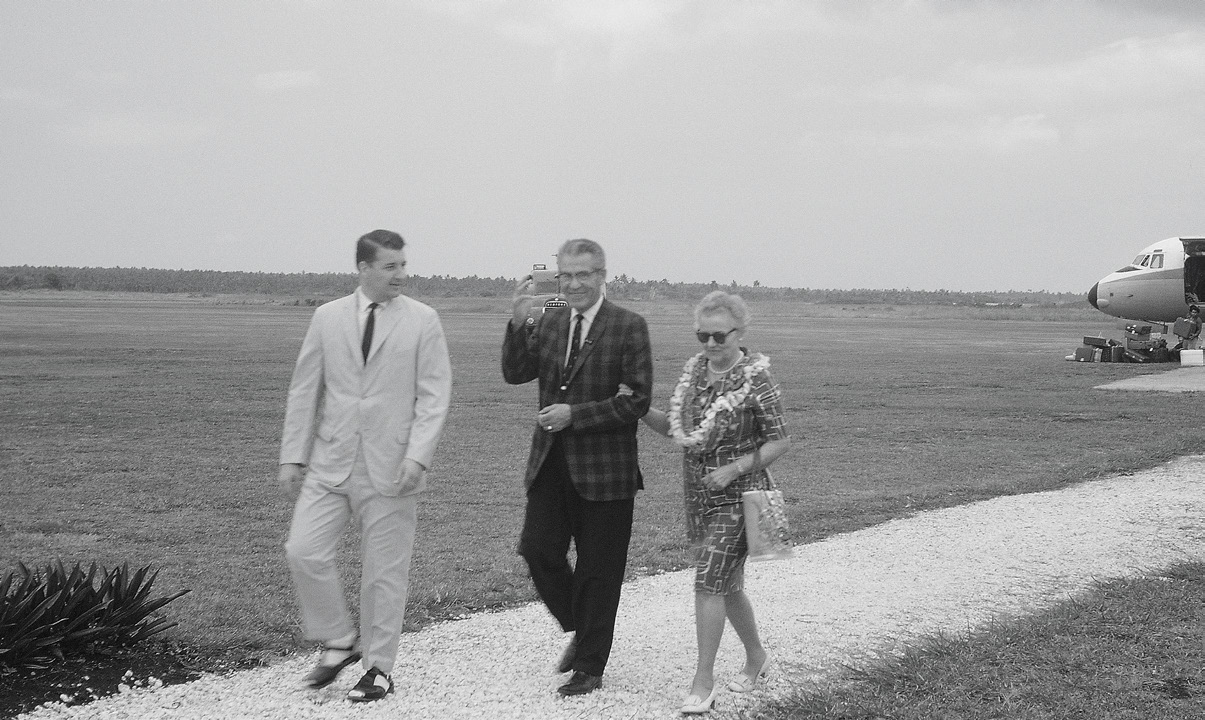 President John H. Groberg greeting President and Sister N. Eldon Tanner at the airport.
President John H. Groberg greeting President and Sister N. Eldon Tanner at the airport.
Courtesy of Jerry Dobson.
President Paletu‘a’s path to joining the Church hadn’t been easy. After attending Makeke for several years, he announced to his family his desire to be baptized. His father showed so much anger that he delayed his baptism. But in 1942, his desire to become a member outweighed the fear he felt and the possible consequences. He had barely reached the age that gave him the legal right to make his own decisions. The night before his baptism, his father found out about it. As planned, Tonga was baptized the following morning, a Saturday. His father had been drinking the night before. As Tonga was being led out of the ocean, having just been baptized, his father suddenly charged down the path to the ocean with a club in hand. The two missionaries who were performing the ordinance were obviously frightened and began to run away. President Paletu‘a’s father began beating his son, who offered no retaliation. The father left his son there in the ocean, with blood streaming from the wounds covering his back, some of which left permanent scars. The missionaries returned and wanted to take Tonga to the hospital, but he declined, saying, “No, I need to be confirmed a member of the Church. I’m not yet a member.” He was confirmed right there on the beach.[52]
During the weeks after he selected his counselors, President Groberg visited all the areas of the Tongan Mission, including Niuafo‘ou and Niuatoputapu. Most of this travel consisted of riding aboard the newly built missionary boat, the Faifekau. He also conducted interviews with members of the Liahona graduating class to determine their willingness and worthiness to serve as missionaries. A week later, a missionary training school began. As the number of missionaries grew, new appointments were created for assisting the missionary effort. Some of these appointments were Viliami Sovea Kioa, legal matters; Fakatou Vaitai, building; ‘Uliti Uata, business; Peni Mapa, translation; Viliami Pasi, organization; and Mosese Muti, fellowshipping program.
President Groberg had three major goals that helped him prioritize his schedule so he could work with the people. A mission president’s duties required administrative functions, with over ten thousand members, thirteen districts, over fifty branches, and about two hundred missionaries. First, he wanted to go out among the people and preach the gospel. He told his zone leaders that anytime they could get fifty investigators together in a chapel, he would come and preach the gospel to them. Second, someone in Salt Lake City had said that native elders couldn’t be as successful as palangi elders, and he wanted to prove that false. Consequently, he worked hard to improve the quality and preparation of the local elders. The third goal was something close to his heart: the planning of a Golden Jubilee to be held in 1968 as a belated fifty-year anniversary of Tonga becoming its own mission. This was especially important to him, as these kinds of celebrations are very meaningful to the Tongan people.
In November of 1966 a temple excursion to the New Zealand Temple was planned. Unfortunately, several problems had arisen in getting all the arrangements made leading up to the trip. On November 23 the temple excursion, consisting of 105 Tongan members, finally departed for New Zealand. President Groberg later recalled that Elder Hinckley had asked him to help Ermel Morton with the temple dialogue and that by 1966 the Tongan Saints were turning in a vast number of names for temple work.
The year ended with over six hundred baptisms, down a bit from the previous year.[53] One of President Groberg’s main objectives was to improve relations with the those segments of the kingdom who did not belong to the Church, particularly the hou‘eiki and the royal family,[54] as well as to work with retention and reactivation of the large number of recent converts. The year 1966 ended very successfully, culminating in the temple trip to New Zealand. Unfortunately, some who wanted to go were unable to attend, mostly for financial reasons. This just reinforced the hopes and desires of the Saints to one day have a temple in Tonga.
Elder S. Dilworth Young Visits
S. Dilworth Young of the Presidency of the Seventy and his wife, Hulda, arrived in Apia on March 16, 1967, for an extended visit to the South Pacific, mainly to inspect the Church schools in Samoa and Tonga. The next day, President and Sister Groberg, Elder and Sister Young, and Brother and Sister Cottle of the Church Building Department boarded the ship Tofua for a voyage to Niue (part of the Tongan Mission at the time). As they approached Niue, the seas became very rough, and the captain deemed it unsafe to dock on the island because of the dangerous conditions. President Groberg and Elder Young did all they could to get ashore, but the captain refused. They finally got permission for Feki Po‘uha,[55] the Niue District president, to come aboard the ship. There he met with Elder Young and President Groberg for about an hour, and a spiritual meeting took place. Feki conveyed the love from the members on Niue. Although the Youngs were disappointed that they were not able to meet the Saints and missionaries of Niue, Elder Young assured Brother Po‘uha that there would be other times.
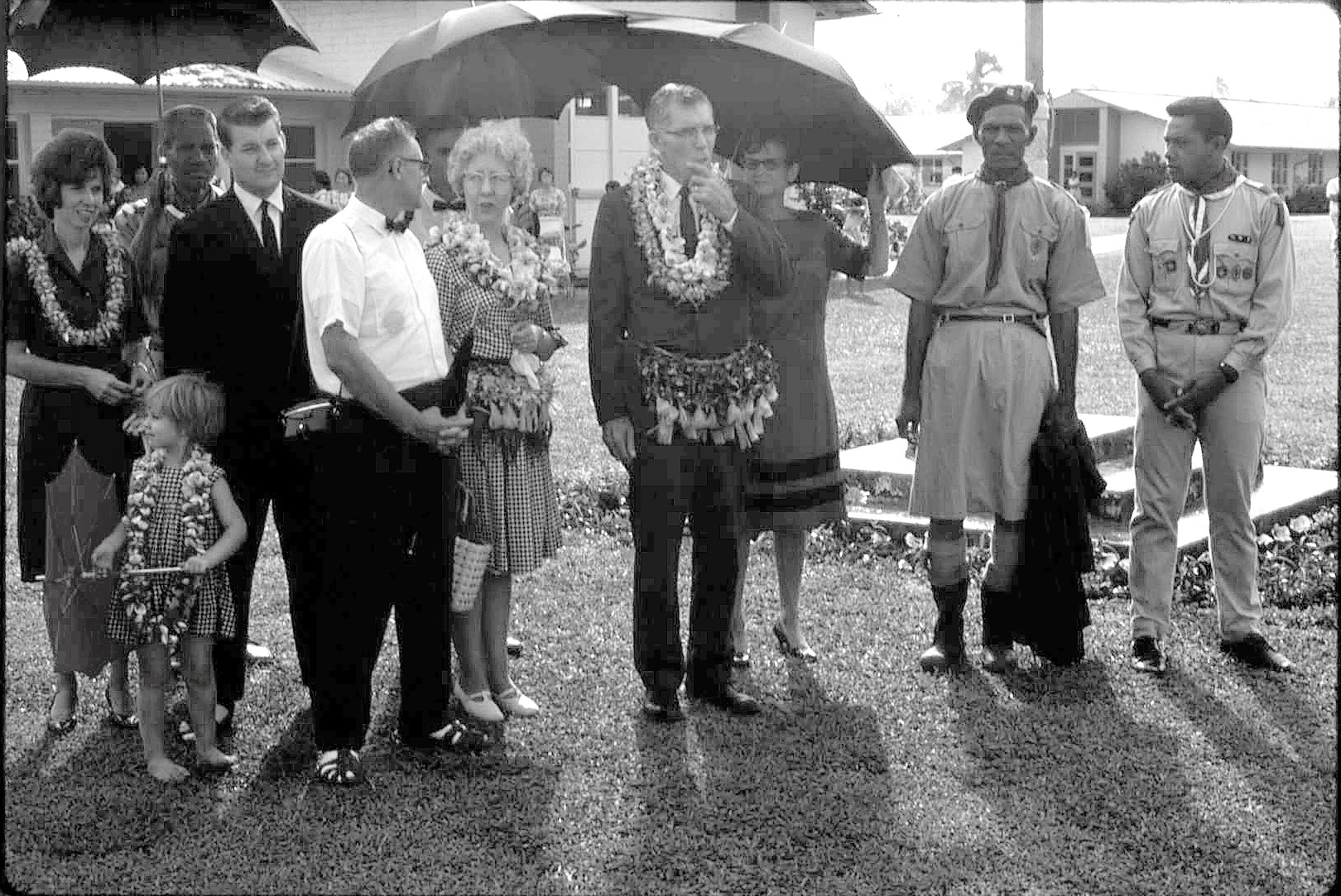 Elders John Groberg, Rondo Harmon, and Dilworth Young.
Elders John Groberg, Rondo Harmon, and Dilworth Young.
Their next destination was the Vava‘u island group. Several hundred Latter-day Saint schoolchildren met them at the wharf, singing Primary songs. Elder and Sister Young were delighted to see the children and hear their voices. Elder Young pleased the boys by teaching them an Indian war dance. After a tour of the chapels on the main island of Vava‘u, they held a session of conference. The group then departed on board the Tofua for the main island of Tongatapu. There, Elder Young and President Groberg spent a day inspecting potential building sites for chapels. On the afternoon of March 27 President and Sister Groberg escorted Elder and Sister Young to the royal palace, where they had a special meeting with King Taufa‘ahau Tupou IV. They presented a painting of the king’s mother, Queen Salote, who had recently passed away. The king was pleased and touched by the work of the Latter-day Saint artist who had painted the portrait from a photograph. Their meeting lasted an hour. He was also very happy to hear about the Scouting program in Tonga. Elder Young was a very strong supporter of the Scout program and was encouraged to see that the Church was the main supporter of the program in the kingdom.
The Tongan Mission was divided into thirteen districts, with quarterly district conferences each year. Many branches were scattered over the islands, including Fiji and Niue. President Groberg had been encouraged to attend as many quarterly district conferences as he could, but this posed huge difficulties. When traveling outside Tongatapu, he depended on irregular sailing schedules and could easily be stranded on an island for weeks, thus making quarterly visits to each district conference, especially in the outer islands, problematic. President Groberg depended on his good counselors to assist in attending many conferences. They took the burden off President Groberg, who had many other issues to attend to. As was the custom in Tonga, a feast was nearly always prepared for attendees. When he could attend district conferences, he often took his wife and children. There were not yet any stakes in Tonga to relieve some of the burden placed upon the mission leadership as the Church grew.
Church Services Established
During May 1967 the official start of a separate translation department in Tonga took place. William Roberts, president of the Auckland New Zealand Stake and newly appointed coordinator of the Translation Services Department for the South Pacific, interviewed members to serve in this program. He was accompanied by Young Men’s Mutual Improvement Association (YMMIA) president G. Carlos Smith. The experience was very spiritual as those selected to be part of the newly created Translation Department were set apart.
Derek F. Metcalfe from the Genealogical Department arrived on June 12 to survey the records in Tonga that could be microfilmed. He then went to Fiji and was impressed with both the number and quality of the records he saw there. If they could be microfilmed, they would be a valuable source for the Saints to prepare names for temple work.
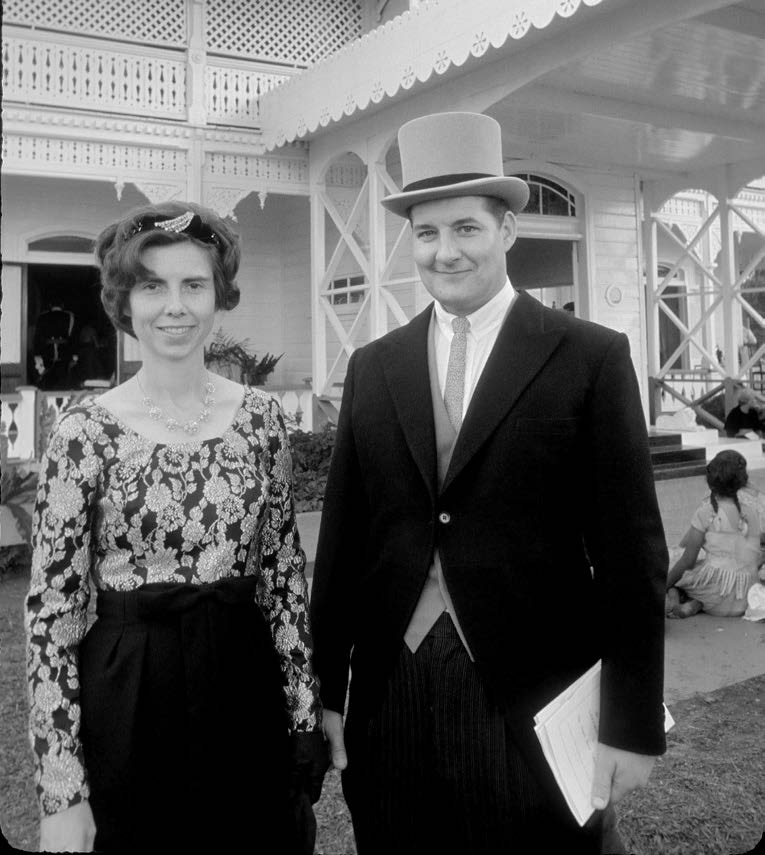 President John and Sister Jean Groberg at the coronation of His Majesty King Taufa‘ahau Tupou IV. Courtesy of John Groberg.
President John and Sister Jean Groberg at the coronation of His Majesty King Taufa‘ahau Tupou IV. Courtesy of John Groberg.
On September 4, 1967, William Roberts, the manager of translation and distribution for the South Pacific Area, arrived from Auckland, New Zealand, to continue work on the translation program. He held a meeting with members of the local Translation Department, consisting of Tupou Pulu, Maile Niu, Sovea Kioa, and Peni Mapa. They investigated the possibility of a centralized distribution operation in Tonga.
Regarding developments with the Translation Department, the Grobergs traveled to Auckland on November 17, 1968, to attend a mission presidents’ seminar. Elder Monson and Elder Dunn presided at the meeting. They discussed many issues and gave clarity so that a common understanding was reached on several of the larger real estate and translation issues. Up to this time, translation of Church materials was done locally by volunteers, but after 1968 the translators were paid. Sione Tu‘alau Lātū, who had come to New Zealand with the Grobergs, had been attending the temple during these meetings. He was called to Auckland and invited to assume the duties of translation co-coordinator over Tonga, a calling he accepted with much humility.
During 1967 the number of local missionaries grew, as well as missionaries from overseas. The traditional method of taking care of the missionaries was through the members, who fed them and provided living quarters. With the increase in the number of missionaries, this started to become a challenge. This issue was magnified by frequent radio broadcasts that were afforded to all religious denominations by the local radio station. Rather than preaching or delivering sermons, the radio time was often used to disparage the elders and to portray them as burdens on society. A movement among other faiths began to develop.
After one such radio program, President Groberg received inspiration to curtail the negative dialogue by starting missionary gardens. Accordingly, the mission established gardens, leasing plots of land and planting food crops such as taro, ‘ufi, and kumala. Rather than proselytizing and doing normal missionary work on Fridays, the missionaries would work in the gardens. They would cook their own lunch in an umu (underground oven) and then continue on hoeing the weeds for the rest of the afternoon. Missionary work was still performed, but usually in the evenings through appointments. The Church went on radio to explain this program both to members and to those not belonging to the Church, and that seemed to satisfy the critics.[56]
The Grobergs met with Adi Loa Naufahu from Fiji on June 20 to see what could be done to introduce the gospel to the royal family. She was a half sister of the king and a strong member of the Church. The Grobergs also visited the Uvean people on Wallis Island two days later. They found these faraway islanders spoke Tongan but had not been visited by Latter-day Saint missionaries since Elders James Welker and Robert Smith had stopped there and were unsuccessful in attempting to introduce the gospel in November 1896. The Grobergs were likewise unsuccessful.
Coronation of Tupou IV
Following an eighteen-month period of mourning for the beloved Queen Salote came the most important event in the kingdom for 1967—the coronation of King Taufa‘ahau Tupou IV. Formerly known as Prince Tungī, he was a good friend of President Groberg from his earlier missionary days. The Grobergs were invited to the coronation to be held on July 4, the king’s birthday.
The Grobergs had just returned on June 27 from Uvea and discovered that to attend the king’s coronation, President Groberg needed a special “mourning suit,” including gloves and a top hat. He phoned President Barnes of the New Zealand mission in Auckland and gave him his sizes and measurements. President Barnes made last-minute arrangements with a local renter to have the suit fitted to order. Bishop Percy Harris of New Zealand brought the suit with him to Nuku‘alofa, arriving on a specially chartered flight on July 2. The Grobergs were finally able to RSVP and mentioned to the secretary of government, Mike Challons, that the suit had arrived. His response was, “My, that’s some organization you have.” President Groberg replied, “Yes, it is. And we’ll have to tell you more about it at some future time.”[57] The presence of the Church at the coronation was very important.
Many dignitaries were in attendance, as well as foreign media. Chartered flights brought in many guests and visitors. The Liahona dorms accommodated two hundred visitors. For some of the guests, the accommodations at the dorms were not quite what they were used to, but there were many opportunities for gospel conversations.[58]
Among the various overseas delegations arriving on July 3 were Governor Rex Lee of American Samoa (a relative of President Groberg), Governor John Burns of Hawaii, and former governor Pat Brown of California. Without question, this was one of the biggest weeks in Tongan history. This was the first time they had crowned a new monarch since Queen Salote ascended to the throne in 1918, nearly fifty years before. President Groberg and his wife arrived at the Royal Chapel early in the morning. There were literally thousands and thousands of people coming for the coronation, but only a small handful could attend the actual coronation in the chapel because it held only one to two hundred people. These included the official overseas delegations and the heads of the local churches, but mainly the ranking nobles and ministers of the government of Tonga. The impressive ceremony was of a religious nature, conducted by the head of the Wesleyan church from Australia.
After the coronation ceremonies and a meeting with the visiting dignitaries and heads of government, the king and queen stood for an hour or so on the balcony of the palace, while more than ten thousand schoolchildren marched past. Thousands of other people thronged around, taking pictures and enjoying the warmth of the occasion. In the afternoon, the Grobergs attended a special open house at the king’s summer residence in Kauvai, where the duke and duchess of Kent were honored guests. The Grobergs briefly met with the king and queen and offered their congratulations, wished them a long and righteous reign, and hoped to witness the promises given to the king and queen during the coronation ceremony that they would rule in righteousness. “There was a very definite feeling that the Church had now taken its place on an official level with the other churches who in the past had felt that Tonga was strictly their province and they could do just as they pleased.”[59] This coronation was far different from the coronation of Queen Salote in 1918 when the mission president was the only church leader not invited.
Knowing that the month of July could be a very difficult month for missionary work because of the festivities associated with the coronation, President Groberg issued a challenge to all the missionaries to be more diligent in their labors. As a result, July 1967 wound up being one of the highest months of the year for convert baptisms as the missionaries truly dedicated themselves to the Lord’s work.
This turned out to be a very important and memorable week for all of Tonga, as well as the Church. As head of the Church in Tonga, the Grobergs were included in the official events.[60] On July 11 the Grobergs, along with members of the mission Relief Society presidency—including Tu‘avava‘u Mapa and Mildred Cottle—and several other sisters, called on Queen Mata‘aho. The Relief Society representatives presented the queen with a beautiful quilt that they had made as a coronation gift. In the center of the quilt was a design of the official seal of the Kingdom of Tonga. The queen appreciated this beautiful and thoughtful gift and indicated it was large enough to fit on their extra-large king-size bed. It was used exclusively as the quilt on their bed from then on. While there, President Groberg presented the queen with a copy of the Family Home Evening Manual and took the opportunity to teach the queen concerning beliefs about the family and how the manual was used across the Church as an instructional guide for helping parents teach the gospel of Jesus Christ in the home.[61]
A major change occurred within the Church Educational System in August 1967. Rondo Harmon, superintendent of Church Schools Tonga, was released after a successful tenure as principal of Liahona High School. His replacement, Orson Hyde White, arrived on September 25, together with his family. White was hired not as the principal of Liahona High School, but as superintendent of all Church schools in Tonga, which meant he would preside over the seventy-five teachers and 1,082 students at both Liahona and the middle schools. White noticed the need to reinvigorate the vocational programs that would help prepare Liahona graduates for jobs in Tonga.
President and Sister Groberg, along with Manase Nau and his wife, hosted Laufilitonga and Vaea, both influential nobles in the Tongan government; members of the Cabinet; and Ministers of the Crown at a reception at the mission home on August 13 so he could explain the mission of the Church. They also viewed the film Man’s Search for Happiness.[62]
With the change in the administration of the Church schools, Dr. Harvey Taylor came on October 11 to review operations. The Pacific Board of Education’s work had been combined into a Churchwide Board of Education in late 1964, and Dr. Taylor was then the commissioner for secondary education. Then on October 18 a group of eighty members left for a temple excursion to New Zealand. While there, Bishop Percy Harris of Auckland provided valuable assistance with the temple ordinances performed in the Tongan language.
New Chapel on Niuatoputapu
The Saints of Niuatoputapu, where President Groberg began his mission, had been waiting patiently to have a block chapel built on their island and were thus overjoyed when one was announced. On November 7 a group of labor missionaries, including Archie Cottle, left on the ship Aoniu to begin construction of the Vaipoa chapel. Also aboard the ship was President Manase Nau, first counselor in the mission presidency, who desired to inspect the details, dedicate the site for the chapel, and make sure there were no problems; he wished to verify that everyone supported the building program.
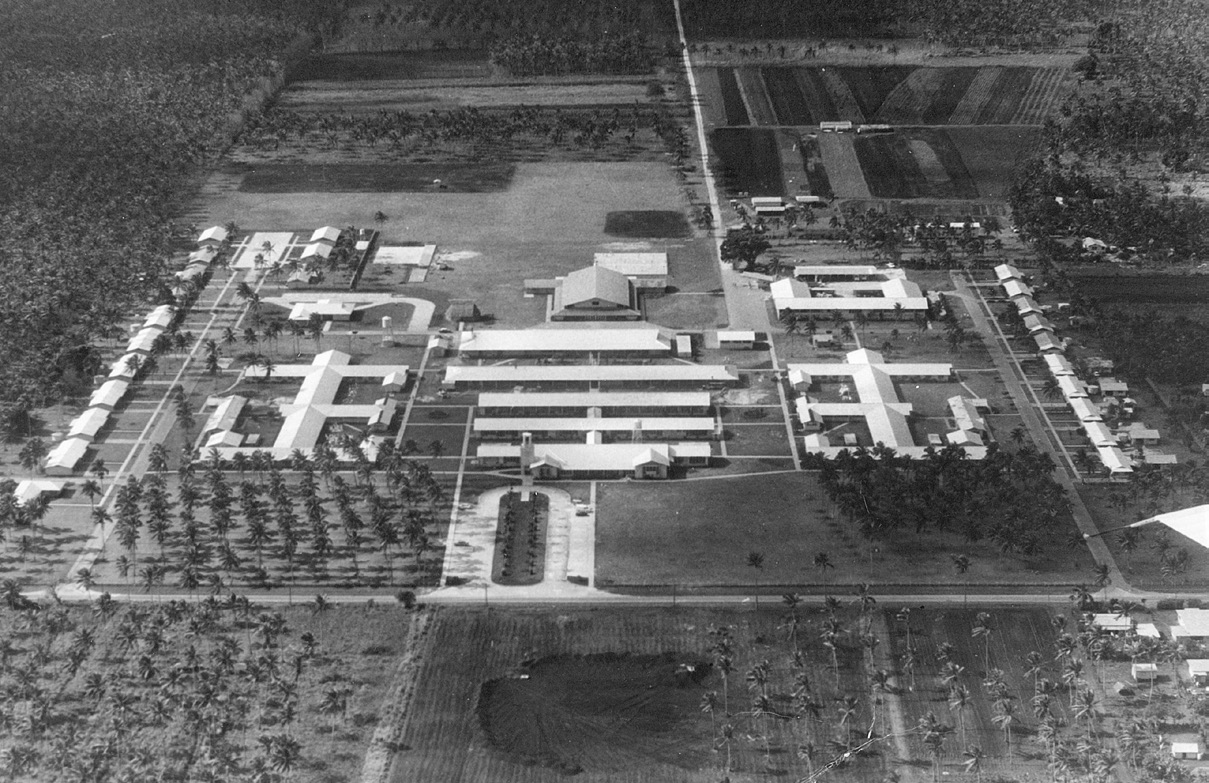 Aerial photograph of Liahona High School 1967. Courtesy of Jerry Dobson.
Aerial photograph of Liahona High School 1967. Courtesy of Jerry Dobson.
Although the Vaipoa Saints had been very faithful and had sacrificed greatly in collecting the required amount of money, it took nearly ten years after the announcement of a chapel in Vaipoa before construction began. President Manase Nau blessed the ground in Vaipoa for the construction of the chapel and was also able to solve a few serious land issues. His presence was valuable, as he carried a lot of influence in resolving the issues with the government and landowners. Both members and individuals not belonging to the Church provided assistance in the construction of the chapel. The level of cooperation from those outside the Church was very high, as they worked side by side with the members. Archie Cottle was amazed by the unity and cooperation in the building of the meetinghouse. Much of the construction work consisted of gathering rocks and sand in gunnysacks that were then hauled by horses in order to stockpile enough materials to complete the construction of the building.
The student dormitories at Liahona made the school a magnet for Latter-day Saint youth throughout the South Pacific. From the late 1950s students had been sent to Liahona from Tahiti and Fiji, where there were few secondary educational opportunities for them. The students from Tahiti had an additional challenge in learning not only English but also some Tongan. Bert Nixon, an assistant principal at Liahona, noted that in 1967 there were thirty-five students from Fiji[63] and in 1968 there were forty-one students from Tahiti.[64] This educational opportunity in Tonga at Liahona enabled several to matriculate on to the Church College of Hawaii and Brigham Young University. They all, however, developed strong testimonies and received valuable training that helped the Church in their home countries.
Prince Tu‘ipelehake Visits Utah
In November a significant event greatly contributed to the goodwill of the Tongan royal family. In the months leading up to November 20, 1967, the Church had extended invitations to Prince Tu‘ipelehake, the prime minister, and Pousima Afeaki, leader of the People’s Party in Parliament, to visit Salt Lake City and Church headquarters. They had come primarily as guests of the United States on a State Department grant to visit various places in America to explore things that might be useful in Tonga.
While in Utah they were treated royally not only by the growing number of Tongans living in the Salt Lake City area but especially by the Church and its leaders and members. Elder Mark E. Petersen made special arrangements for Prince Tu‘ipelehake to visit with President David O. McKay.[65] The prince was invited to tour the Tabernacle and the Church Information Bureau. Here he had the basic precepts and beliefs explained to him, including the apostasy and restoration of Christ’s church and the role of the Prophet Joseph Smith and the Book of Mormon. This was, by far, the most in-depth explanation of the Church that had ever been given to the premier and perhaps to any member of the royal family up to this point in time. Social and political pressures would have made it very difficult for a person of his stature and royal blood lines to consider joining the Church, but in the environment he found himself in on his trip, and visiting with the express purpose of learning more about the Latter-day Saints, it was much easier for him to explore the precepts of the Saints.
Back in Tonga, Prince Tu‘ipelehake subsequently met with President Groberg and President Manase Nau, and expressed on several occasions the “true joy” and appreciation he had developed in learning about the Church. President Groberg noticed the change in Tu‘ipelehake’s view of the Church after he visited Salt Lake City. He felt this contributed to the government’s increase in the number of missionaries allowed from overseas from six to twelve. The Tongan Mission leadership felt that this visit increased the goodwill of other leaders in Tonga because Prince Tu‘ipelehake carried much influence.[66]
In April 1967 Brother Ermel Morton received a letter from President Groberg requesting that he return to Tonga and write a missionary language plan. During a visit by Elder Thomas S. Monson to Ricks College, Brother Morton discussed the Tongan project with him. Elder Monson further clarified that the goal was to write Tongan, Niuean, and Fijian Mission Language Plans designed to help missionaries learn the language, which project had been approved by the Church Missionary Committee.
On December 4, 1967, Brother Morton arrived back in Tonga. He had stopped over in Fiji to study the Fiji Hindi language. An expert in the Tongan language, he held a PhD in linguistics. His assignment was to assist with the translation of the missionary lessons from English into Tongan so the translation could assist the palangi missionaries in learning the language. Brother Morton was the obvious choice for this project because he was a former missionary in Tonga, had translated the scriptures into Tongan, and had served as the principal of Liahona High School for many years. By January 20, 1968, Brother Morton had completed the project and left Tonga two days later. He also researched and began writing a brief history of the Church in Tonga that was published just in time for the Golden Jubilee.[67]
During this same month, the Niue Island District was transferred to the Samoan Mission. Niue seemed to be somewhat of a stepchild, being bounced from mission to mission. Which mission could more easily supervise the island depended on varying shipping and airline schedules.
On March 17, 1968, the Grobergs were blessed with a baby boy, as Queen Mata‘aho had predicted, whom they named John Enoch Groberg. He was the first boy after five daughters. Not long after after his birth, he became very sick with a high fever and was unable to take nourishment. The doctors in Tonga did not have the ability to diagnose or help him. Sick with worry, and at Elder Monson’s encouragement, the Grobergs made arrangements for Sister Groberg to fly back to the United States with the baby for treatment. They were fearful the baby might die before they could get him there. Late one night, someone knocked on the mission home door. President Groberg answered the door, where a delegation, soaked by the falling rain, had come to deliver a message: the leader said that the missionaries and members through the mission, as well as many from other faiths, had held a special fast. They wanted to assure him that the Lord had heard their prayers and that their son would be all right. The Grobergs later learned that the queen and other notable people had also fasted and prayed. Such was the faith of the Tongan Saints and many others. Fortunately, the mother and baby arrived safely in the United States, where he was diagnosed with a congenital defect, treated, and eventually recovered.[68]
Stakehood
By 1968 the Church in Tonga had matured and had the leadership and experience to support a stake. In April, Elder Monson again visited Tonga to observe the progress the mission on Tongatapu was making toward becoming a stake. President Groberg escorted Elder Monson to the royal palace to call upon the king. Elder Monson later said, “[1] accompanied President Groberg to the Royal Palace where we were granted an interview with His Royal Majesty King Tupou IV. Our welcome was cordial and most pleasant. At the conclusion of the interview, the prompting of the Holy Spirit guided President Groberg as he bore fervent testimony to the King concerning the truth of the Everlasting Gospel and the blessings which it provides the faithful. No more eloquent nor moving words have resounded in those royal chambers. No greater courage have I seen displayed.”[69] They “encouraged him to be baptized and to encourage all of his people to come to the true church as soon as possible.”[70]
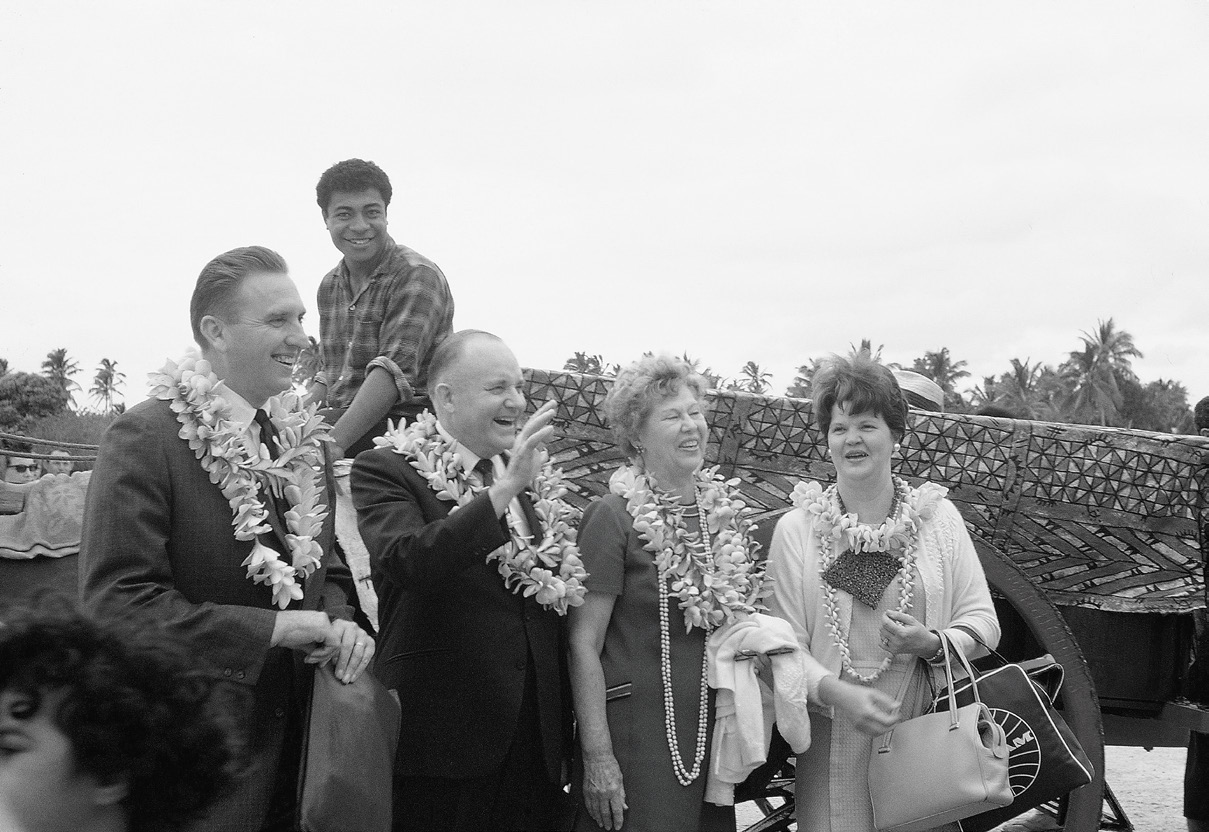 President John Groberg and Elders Howard W. Hunter and Thomas S. Monson in a saliote.
President John Groberg and Elders Howard W. Hunter and Thomas S. Monson in a saliote.
Courtesy of Bill Windsor.
President Groberg received word on June 16 that Elder Monson’s recommendation to form a stake had been approved and that he and Elder Howard W. Hunter would arrive on September 4 to create the first Tongan stake in Nuku‘alofa.[71] When they arrived, the Apostles immediately set about interviewing priesthood leaders. The superintendent of Church schools, Orson White, was called to be the stake president. He selected Tonga Toutai Paletu‘a and ‘Uliti Uata as his counselors, with Jay Cahoon, a former mission president in Tonga then serving in the Latter-day Saint construction program, as the first stake patriarch. Cahoon was counseled to give his patriarchal blessings in Tongan.
The rest of the stake leaders were a mix of Tongans who had served in various district positions and faculty at Liahona. The Nuku‘alofa First and Second Branches, along with the Haveluloto, Tokomololo, Pea, Ha‘ateiho, Matangiaki, Liahona, and Ha‘akame Branches, were made wards with local bishops. Elder Monson said this was the first time he was aware of that all stake offices could be filled from a mission at the creation of a stake. This spoke to the preparation and training the men and women of the stake had already cultivated. In a letter written back home on September 7, 1968, President Groberg explained that the new Nuku‘alofa Stake had eight wards and 3,500 members. Elders Monson and Hunter remarked that they “have seldom if ever seen more depth of leadership or been able to completely staff a foreign stake on the very first go around.” Because of the abundance of leadership they both commented that it was already time to divide the existing stake.[72]
Golden Jubilee Celebration
The 1968 celebration, called the Golden Jubilee, began when President Groberg had a strong intuition about holding a celebration when he was still a bishop in Idaho Falls. At the time he didn’t know he was going to be called as a mission president. When he became president, the urge to hold a celebration was stronger and continued to grow. A committee was formed to plan the historic celebration, aptly named the Golden Jubilee. President Groberg was notified on September 1 that N. Eldon Tanner, Second Counselor in the First Presidency, would attend. The goal of the celebration was to commemorate the first fifty years of the mission in Tonga. While some questioned the actual date of the establishment of the mission in Tonga, President Groberg based the celebration on the time frame of Tonga’s becoming its own mission and holding its first mission-wide conference in 1918. Additionally, the jubilee could not have been held in 1966 or 1967 because of the mourning period for Queen Salote and the coronation of King Taufa‘ahau Tupou IV.
All members, friends, and missionaries from all the islands, including the remote islands, were invited to attend, not only to celebrate but to be blessed by words of counsel and inspiration from local leaders, as well as from President Tanner. The last speaker of the general meeting was to be His Majesty, Taufa‘ahau Tupou IV, who attended, along with several members of the royal family.[73]
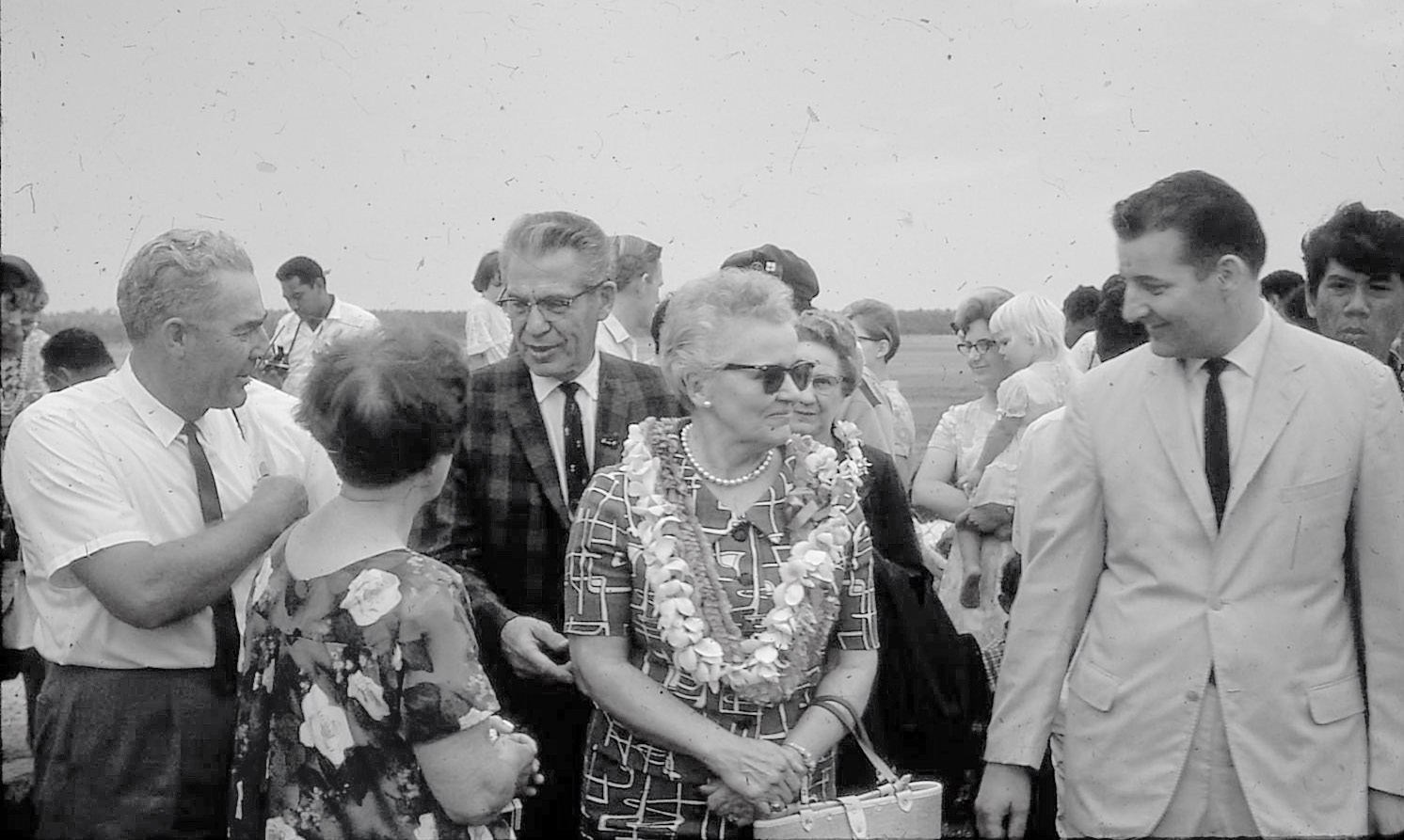 Elder and Sister Jay Cahoon
Elder and Sister Jay Cahoon
and President John Groberg greet
President and Sister N Eldon Tanner. Courtesy of Bill Windsor.
Two other goals President Groberg had planned for the conference were to encourage the Saints to begin to identify their ancestors and prepare their names for temple ordinances and to put an increased emphasis on missionary work and baptisms. Preparations had been going on for over a year. The creation of the Nuku‘alofa Stake was an unanticipated bonus. President Groberg told his missionaries to focus on missionary work, and he felt the Lord had prepared five hundred souls to be baptized in the month of November. They had been baptizing around eighty converts per month, but they prayerfully promised to reach the goal.
The outer island Saints were billeted in four massive fale across the road from Liahona. Preparations came together miraculously and on time. The Jubilee started with two days of sports, a beautiful handicraft bazaar by the Relief Society, and a grand ball in the gymnasium. When President Tanner visited the “instant village” across from Liahona, he asked about the cost, legal issues, and accidents. President Groberg simply responded that there weren’t any. The Jubilee services commenced on November 29. The king and queen were invited and participated in the celebrations held at Liahona. President Tanner was introduced to the king, who was the concluding speaker. The king had planned to speak for ten minutes but spoke for half an hour. Then everyone went to the rugby field for a huge feast planned for five thousand. However, six thousand five hundred came to eat and partook of two thousand roasted pigs and mountains of other Tongan delicacies. “The participation of the Island’s ruler and President Tanner was a great welding link between Tonga’s nobility and the Church.”[74]
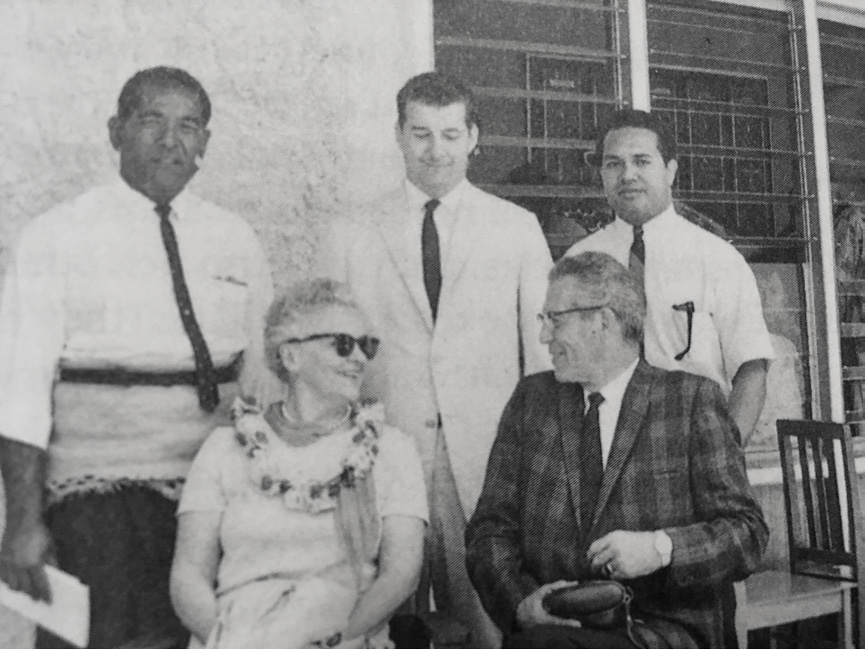 The Tanners and the mission presidency.
The Tanners and the mission presidency.
Toward the end of the feast, while the Saints were performing their specially arranged native dances, President Groberg recalled seeing a vision. He saw a beautiful white building slowly descending from the sky, with the angel Moroni at the top of the building guiding it to a spot near the Liahona campus.[75] He kept this to himself, but several years later, when the announcement was made that a temple would be built in Tonga next to Liahona, he wrote of this 1968 experience:
A feeling of peace came over me and I knew that, through the goodness of God, the fire of faith had been successfully passed from one generation to another; and through that same goodness, this generation would successfully pass it to the next generation. Soon they would be blessed with one of the greatest of all the blessings of Zion, a House of the Lord. I knew a temple of God would one day stand in Tonga. I kept this in my heart and said nothing to anyone about it until it was fulfilled. I knew the spirit of this Jubilee would ripple throughout eternity.[76]
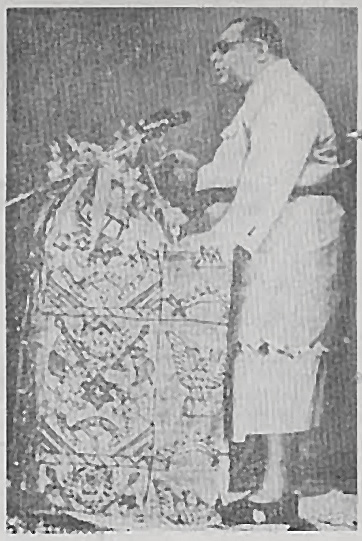 King Taufa ‘ahau Tungi VI addresses the Golden Jubilee. Courtesy of LDS Church News.
King Taufa ‘ahau Tungi VI addresses the Golden Jubilee. Courtesy of LDS Church News.
After President Groberg’s challenge to his missionaries, baptisms jumped to 254 in October, then surpassed their goal of five hundred by baptizing 507 in November, and followed that with 175 in December. Eventually 1,767 converts were baptized in 1968, compared to 604 in 1966, and 838 in 1967.[77] At this time, besides the new stake, there were ten districts and fifty independent branches in Tonga.
Superintendent Orson White had led a “de-Americanization” program of Church schools in Tonga during 1968. Students could prepare for and take the Tongan Higher Leaving Certificate examination. Over time, Liahona’s pass rate became one of the highest in the nation. At this time Liahona’s student population included 550 Tongans, 32 Fijians, 33 Tahitians, 13 Americans, and 2 Niueans.
By the end of 1968 there were eleven middle schools besides Liahona that were educating 1,650 students. Liahona was a magnet for students from all over the Pacific because it was the only school designed for boarding students. Daily religion classes were part of the curriculum. Dr. Taylor said, “The gospel must be taught so effectively that all of our students will incorporate it in their lives, being active members of the Church regardless of the avenue they take in providing themselves and their families with a livelihood.”[78]
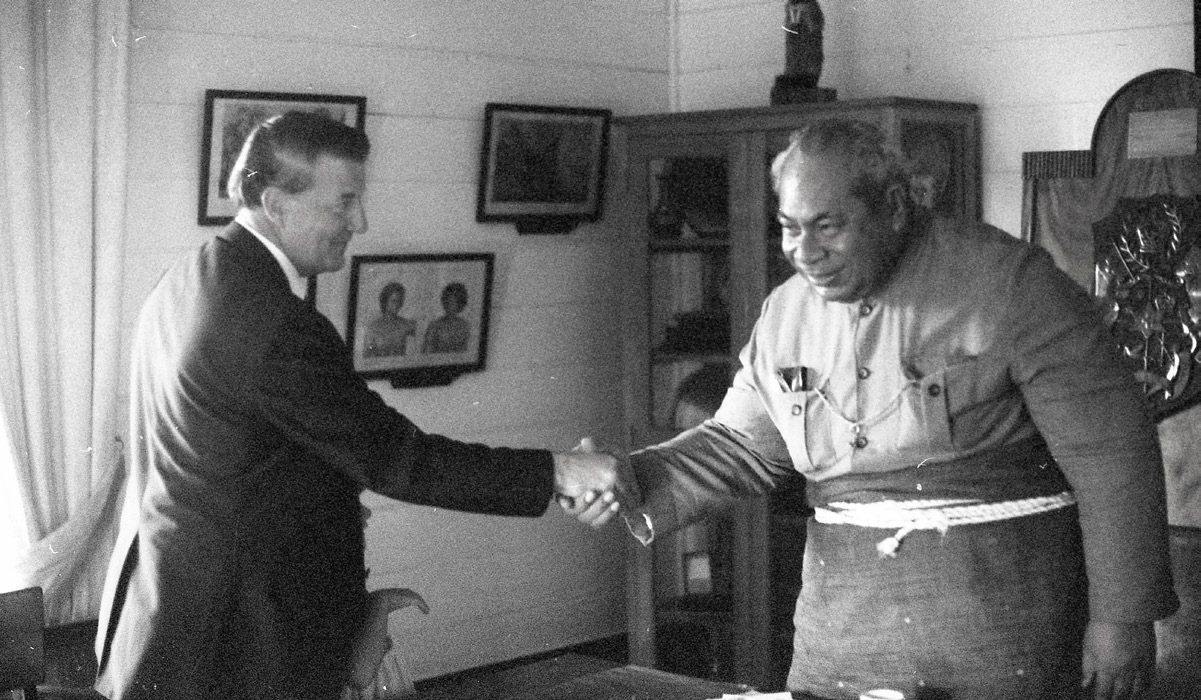 Elder John Groberg visiting King Toupou IV in 1983. Courtesy of John H. Groberg.
Elder John Groberg visiting King Toupou IV in 1983. Courtesy of John H. Groberg.
As the membership of the Church in Fiji grew, plans were made to open a primary school in the large Suva chapel. Charles and Blossom Mohi from New Zealand were called as headmasters. They arrived on January 7, 1969, and the Suva Primary School opened on February 3. It quickly grew and, like the Church schools in Tonga, proved a great missionary tool. It provided valuable educational opportunities that the children may not otherwise have had.[79] Dozens of secondary students from Fiji had been attending Liahona for years, and eleven of the first group of Fijian graduates from Liahona left to attend the Church College of Hawaii on December 9, 1969. They included Maraia Sokia, Elliot Lobendahn, Hiagi Wesley, and Joshua Mara. President Groberg noted that just thirty-eight attended the first district conference he held in Fiji in 1966, but at his last held in 1969 three hundred attended.
James P. Christensen Replaces John H. Groberg
President Groberg completed his mission in 1969 and was succeeded on July 1 by James P. Christensen,[80] who had served in Tonga in the 1950s, and his wife, Metta Heder Christensen, who had been called as a teaching missionary at Liahona from May 1955 to November 1957 where she had become very well versed in the Tongan language.
When Christensen arrived in Tonga, an approved new mission home had not been started. Manase Nau helped President Christensen locate a choice piece of land on the beach at Sopu that belonged to the king. That day he, along with William Roberts, the Church’s real estate agent from New Zealand, decided to lease this property, and construction commenced. President Christensen later decided to change the floorplan and place the room reserved for visiting authorities to overlook the beach. Over time, this change became very popular with visiting authorities, especially President Kimball, who loved to walk on the beach and collect shells.
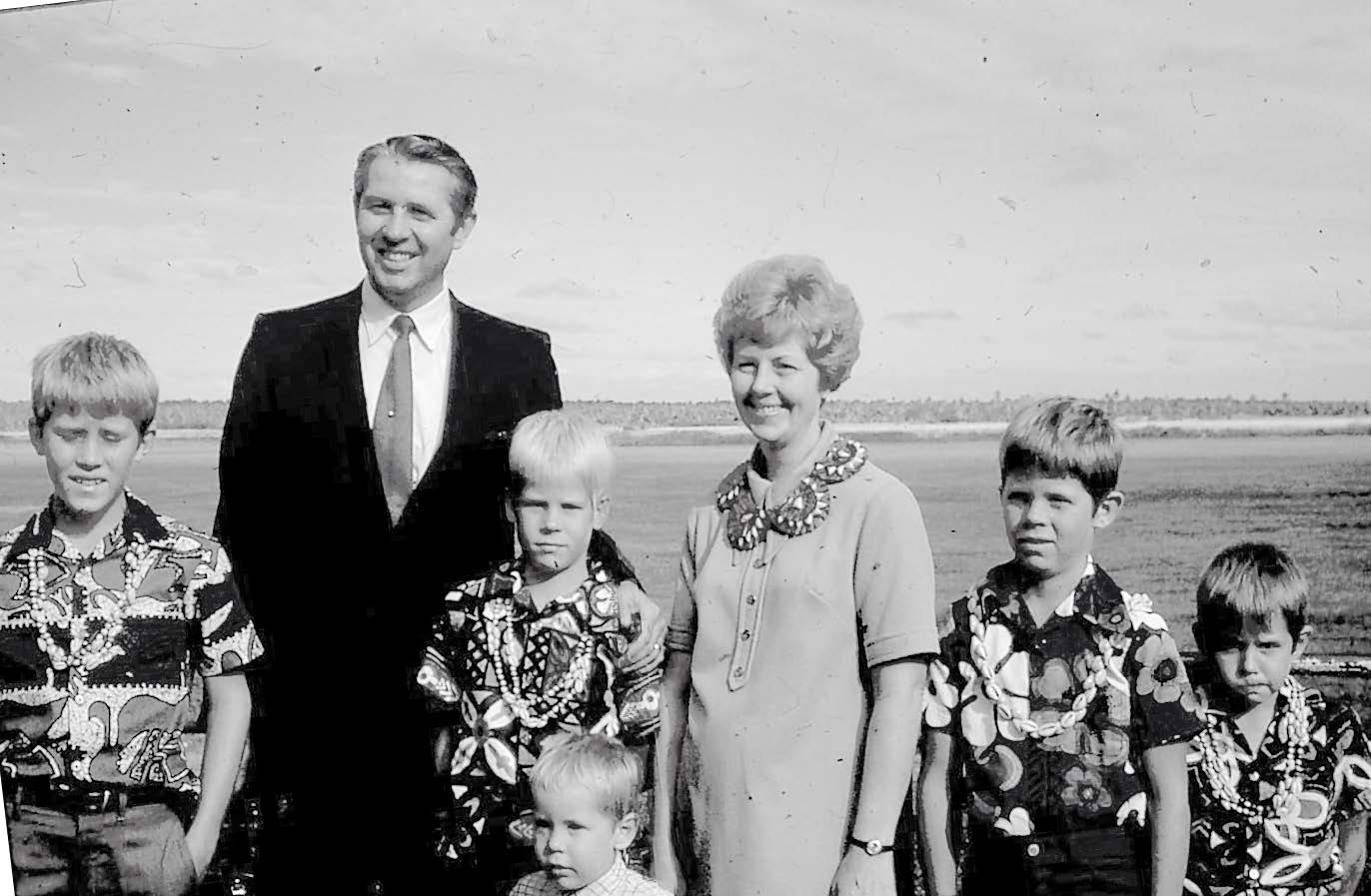 President James and Sister Metta Christensen and their family. Courtesy of Bill Windsor.
President James and Sister Metta Christensen and their family. Courtesy of Bill Windsor.
With the creation of the stake, General Authorities began visiting on a more frequent and regular basis to preside over stake conferences. Among those who visited in 1969 were Elders Howard W. Hunter, LeGrand Richards, James Cullimore, ElRay L. Christiansen, and Henry D. Taylor. Chapel construction continued with buildings dedicated in Fahefa, Vaotu‘u, Tokomololo, Faleloa, Fotua, and Ta‘anea. Also, in 1969 a new student health center was built on the Liahona campus. This meant sick students did not have to go in to Vaiola Hospital in Nuku‘alofa except for major problems.[81]
Shortly after he returned home, John H. Groberg was called as the new regional representative for Tonga and Samoa. This new assignment would require him to travel to the islands on a regular basis to supervise the missions and stakes there.[82]
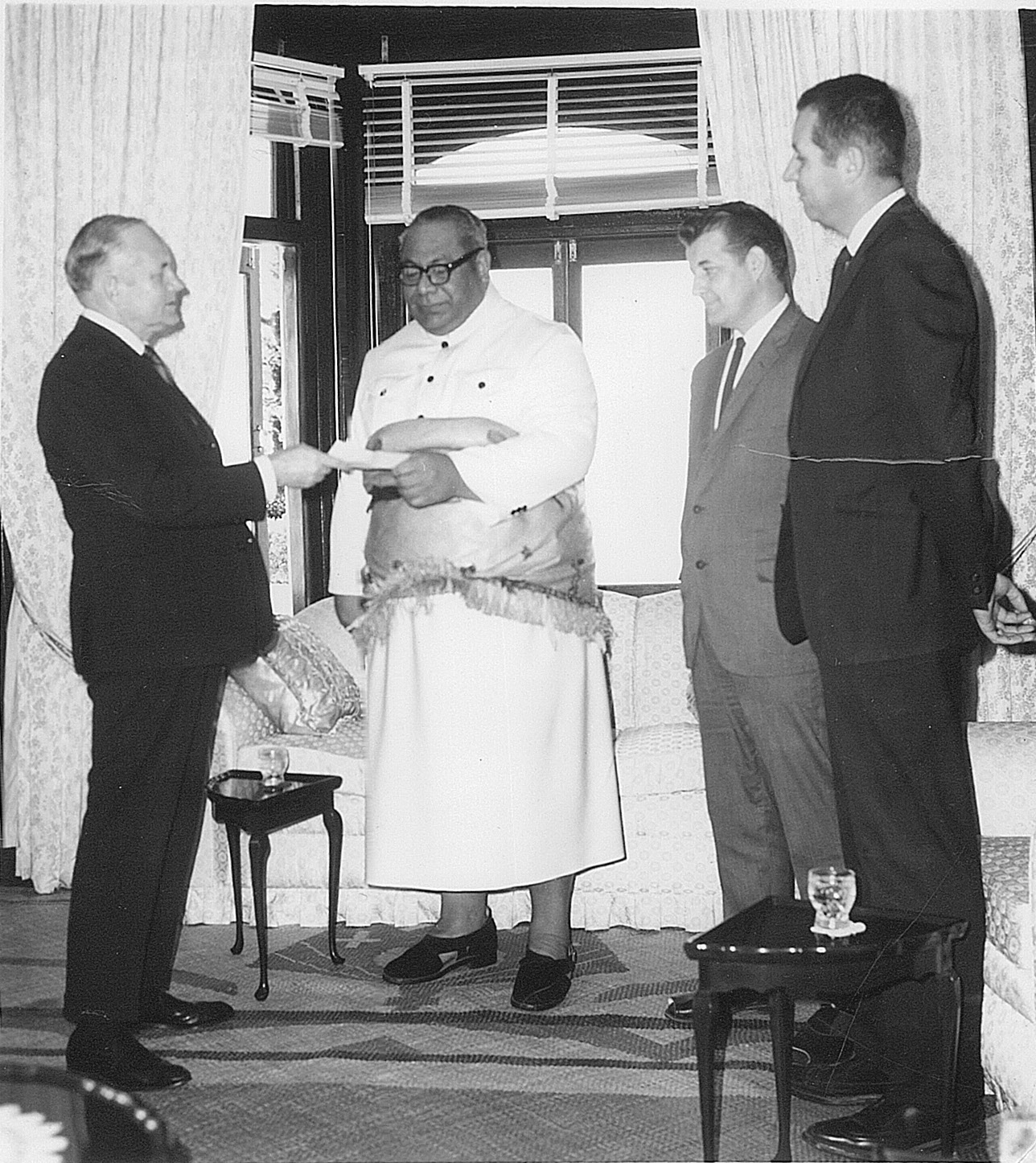 Elders Howard W. Hunter, John
Elders Howard W. Hunter, John
Groberg and President James
Christensen visit with His Majesty
King Taufa‘ahau Tupou IV. Courtesy of Jerry Dobson.
The growth of the Church in Tonga in the 1960s was extraordinary. The early struggles of the missionary effort and the hard work that often resulted in disappointment began to pay great dividends as the Church grew.[83] Still, it was often discouraging to visit the outer islands of Ha’apai and Vava’u and meet with the small branches where some members had returned to their old churches because there was little leadership. They were basically on their own if there were no missionaries on the island. Some of these small islands had no resident priesthood leadership at all. Little by little, however, the missionary work began to pay off. The incredible faith of the missionaries and the members began to reap faith-promoting rewards as small branches were formed, and either branch presidents were called from the membership or married missionary couples were sent to the smaller islands. A beautiful glimpse of missionary work in the 1960s and the groundwork laid during this decade was summarized by a missionary at the time, Pita Hopoate, who later served as a bishop, stake president, mission president, temple president, and Area Seventy. He recalled a sacred dream he experienced in 1967 which later found fulfillment:
Missionary work in the late sixties in the western isles of Ha‘apai (Lulunga) was difficult at best. The distance, the dangers of the ocean, and the fragile testimonies of only a few members did not promise a strong membership for the future. But the Lord has His way of strengthening through dreams and visions those who are to lay the foundation for the growth of the Church. As a missionary I was part of those initial proselytizing efforts in Lulunga.
One night in 1967 on the island of Ha‘afeva, I went to bed very hungry and perhaps a little overwhelmed by the hardships of missionary work in these islands. I slept and dreamed a dream. The vividness of the dream or vision made a powerful impression on me. I saw myself sitting on the beach of Ha‘afeva Village, looking out on the ocean which was suddenly full of small boats of every variety and shape. They were vessels coming from the different islands of Lulunga to Ha‘afeva full of members of the Church. I was amazed to see fathers and mothers whose children were dressed in the green uniforms of our own Church schools. The boats landed on the beach and the saints walked up and into large, beautiful Church buildings.
Awakening from this “unlikely” dream, I walked down to the shore early the next morning. Sitting on a beached outrigger canoe, I looked out on the very ocean I saw in my dream the night before. Again in my mind’s eye, I envisioned the little armada of boats full of saints from the various islands coming to Ha‘afeva. The children were dressed in green Church School uniforms.
It was a strange dream since the Church in Lulunga in 1967 was just beginning to grow. For example, the Ha‘afeva Branch, presided over by Brother Hivapea‘ulu and his wife, was made up of a few children and teenagers. A Tongan hut (fale) served as the Chapel.
However impossible it seemed at this time that such an “invasion” of saints and school children could ever occur, I did in fact witness the fulfillment of that singular dream fifteen years later when, as mission president, I went to Ha‘afeva to dedicate a new chapel there. The Church had established a middle school on Ha‘afeva for the children of the Lulunga islands and I stood on the beach and greeted the saints arriving in boats from ‘O‘ua, Tungua, Matuku, Nomuka and Kotu, bringing these uniformed children to enroll them in school and to attend conference. These were the saints I saw in my dream-vision back in 1967.[84]
Thus, the 1960s saw the reaping of the rewards that came from longer-term leadership training as the Tongan Saints carried much of the burden of service and leadership in their little branches that were now preparing to become fully functioning wards in strong stakes.
Notes
[1] “Building Chairman Describes Faith of Labor-Missionaries,” Church News, October 29, 1960, 16. The Tongan labor missionaries left Tonga less than two months later (March 2, 1960) on the Tofua.
[2] “Liku Branch Winners Carry First-Place Shield Back Home from Niue,” Church News, July 15, 1961, 6.
[3] Ermel Morton notes, by date. These notes are similar in format to the official manuscript mission history. They are the notes he used to create his brief history of the Church in Tonga for the Golden Jubilee conference in 1968.
[4] “Ricks Instructor Translates Scripture into Tongan Tongue,” Church News, June 20, 1959, 17.
[5] Morton notes, by date.
[6] “Elder Longden Gets New Assignment,” Church News, October 22, 1960, 4; and “Friends on Friendly Island,” Church News, January 21, 1961, 10.
[7] Eric B. Shumway, “On the Lord’s Errand in the Friendly Islands” (typescript, 2016), in possession of the authors.
[8] Shumway, “On the Lord’s Errand.”
[9] “Hurricane Leaves Tongan Saints Homeless, Hungry,” Church News, April 29, 1961, 6.
[10] Vernon Lynn Tyler, “True Story of Faith in the Tonga Islands,” typescript, CHL. See appendix A for the full story. Tonga Poteki Malohifo‘ou’s version of this event is related in Eric B. Shumway, Tongan Saints: Legacy of Faith (Laie, HI: Institute for Polynesian Studies, 1991), 226–28.
[11] Fred E. Woods and Riley M. Moffat, “An Apostle Visits Tonga: The 1938 Mission of Elder George Albert Smith,” Mormon Historical Studies 19, no. 2 (Fall 2018): 75.
[12] Tyler, “True Story of Faith in the Tongan Islands,” 5.
[13] Tyler, “True Story of Faith in the Tongan Islands,” 8–9. Elder Shumway also tells the beautiful story of Viliami Saulala’s young convert wife ‘Ivoni asking him to return through the storm to their house as it was being blown away to save her primary secretary’s book while she hid under the trunk of a fallen mango tree during the height of the storm.
[14] Morton notes, August 22, 1961.
[15] Delworth Keith Young, “Liahona High School: Its Prologue and Development to 1965” (master’s thesis, Utah State University, 1967).
[16] Morton notes, by date.
[17] Morton notes, by date.
[18] “New Leader Set Apart for Tonga,” Church News, December 29, 1962, 5.
[19] Patrick D. Dalton Jr., interview by R. Lanier Britsch, 1974, 14, CHL.
[20] Dalton, interview, 21.
[21] Morton notes, by date.
[22] During a visit on March 18, 1964, President Dalton described hiking along the shore for 250 yards, then up a 60-degree trail to the village. The saying went that it was easier to get to heaven than to Tafahi.
[23] Morton notes, by date.
[24] Dalton, interview, 22.
[25] Morton notes, by date.
[26] Bert Nixon, “The Nixons in Tonga: Liahona High School: 1962 January–1968 July,” February 5, 1964, CHL.
[27] Dalton, interview, 16; Morton notes; Nixon, “Nixons in Tonga,” CHL.
[28] Young, “Liahona High School.”
[29] Dalton, interview, 26.
[30] “Tonga Toutai Paletu‘a,” in Shumway, Tongan Saints, 212–13; see also Nixon, “Liahona High School,” by date.
[31] Morton notes, March 21, 1964.
[32] Harvey L. Taylor, “The Story of LDS Church Schools in Tonga,” typescript, 2 vols. (n.p., 1971), 143.
[33] “Church Officials Tour LDS Schools in Pacific,” Church News, December 19, 1964, 6.
[34] Vai Sikahema, “Brief History of Liahona College,” in Paula F. Muti and Sisi K. Muti, Mosese L. Muti: A Man of Service, 1911–1993 (Bountiful, UT: self-published, 2016), 129. By 1965 there were twelve middle schools operating in Latter-day Saint chapels in Nuku‘alofa, Ha‘ateiho, Ha‘akame, Liahona, Nukunuku, Vaini, Mu‘a, Kolonga, Pangai, Neiafu, Ha‘alaufuli, ‘Otea. Ha‘atu‘a on ‘Eua was added in 1973.
[35] MHHR, May 27, 1964.
[36] Morton notes, by date. The Church’s radio programs have continued to the present day.
[37] Morton notes, by date.
[38] Morton notes, June 4, 1965.
[39] Part of the Feingas’ story is told in Shumway, Tongan Saints, 229–32.
[40] MHHR, July 26, 1965.
[41] “‘Faifekau’ Is Launched,” Church News, May 14, 1966, 6.
[42] Nixon, “Nixons in Tonga,” October 27, 1965.
[43] Nixon, “Nixons in Tonga,” July 10, 1966.
[44] Young, “Liahona High School.”
[45] Morton notes, by date.
[46] The quotas were still in effect, but this number of foreign missionaries includes those in Fiji and Niue.
[47] R. Lanier Britsch, Unto the Islands of the Sea: A History of the Latter-day Saints in the Pacific (Salt Lake City: Deseret Book, 1986), 468–69.
[48] John H. Groberg, interview by R. Lanier Britsch, 1975, CHL.
[49] John H. Groberg, interview by Brent Anderson, 2018, in possession of the authors.
[50] Morton notes, August 9, 1966.
[51] Groberg, interview by Anderson.
[52] Groberg, interview by Britsch, 15–16. See also Eric Shumway, Tongan Saints: Legacy of Faith (La‘ie: The Institute for Polynesian Studies, 1991), 209–15.
[53] Morton notes.
[54] Nixon, “Nixons in Tonga,” August 29, 1966.
[55] Feki Po‘uha, the district president of Niue, was President Groberg’s first companion as a missionary on Niuatoputapu.
[56] Groberg, interview by Britsch.
[57] Morton notes, by date.
[58] Nixon, “Nixons in Tonga,” July 4, 1967.
[59] Morton notes, by date.
[60] Ermel J. Morton journal, July 1967.
[61] Morton notes, July 11, 1967.
[62] It was President Groberg’s feeling that Laufilitonga and Vaea were two of the fairest nobles in Tonga and probably as close as any to becoming members of the Church.
[63] Nixon, “Nixons in Tonga,” February 14, 1967.
[64] Nixon, “Nixons in Tonga,” January 18, 1968.
[65] “Tongan Prince Visits Pres. McKay,” Church News, November 25, 1967, 3.
[66] Morton journal, November 1967.
[67] Ermel Morton, Brief History of the Tongan Mission of the Church of Jesus Christ of Latter-day Saints, Golden Jubilee (Suva: Fiji Times, 1968), foreword.
[68] John H. Groberg to Brent Anderson, email, July 29, 2019; this story is also related in John H. Groberg, The Fire of Faith (Salt Lake City: Bookcraft, 1996), 122–42.
[69] Thomas S. Monson, “The Miracle of the Friendly Islands,” in Conference Report, October 1968, 80.
[70] Monson, “Miracle of the Friendly Islands,” 80.
[71] “2 New Stakes Formed, 3 Others Reorganized,” Church News, September 14, 1968, 5.
[72] Britsch, Unto the Islands of the Sea, 483.
[73] “Pres. Tanner, Tonga King Highlight Islands’ Fete,” Church News, November 30, 1968, 3. See also “50 Years in Tonga,” Church News, December 28, 1968, 8–9.
[74] “Pres. Tanner, Tonga King Highlight Islands’ Fete,” 3.
[75] Groberg, interview by Anderson.
[76] Groberg, Fire of Faith, 184–203.
[77] Groberg, Fire of Faith, 184–203.
[78] Jack Jarrard, “Church Schools in Polynesia,” Church News, January 4, 1969, 7.
[79] “New Suva School Busy,” Church News, September 6, 1969.
[80] “5 Mission Presidents Called,” Church News, May 3, 1969, 5.
[81] Taylor, “Story of LDS Church Schools in Tonga,” 157.
[82] “2 Regional Representatives Are Called,” Church News, October 11, 1969.
[83] Britsch, Unto the Islands of the Sea, 469.
[84] Personal history of Pita Hopoate, in possession of the authors.
